LLMs
Q4'25: Technology Update – Low Precision and Inference Optimizations
Authors
Nikolay Lyalyushkin, Liubov Talamanova.
About
A quarterly digest on quantization, pruning, sparse attention, KV cache optimization, and related techniques for efficient AI inference.
Contributions welcome! We can't cover everything—if you spot something notable, open a PR in github.com/openvinotoolkit/technology_updates or let us know.
Summary
This quarter's research reveals several converging trends in efficient AI:
- Hadamard and learned rotations are now standard in quantization pipelines. The focus has shifted from whether to use rotations to how to compute them efficiently—via QR decomposition or per-block optimal transforms. New evidence shows integer formats (MXINT8, NVINT4) can outperform floating-point alternatives when combined with rotation-based outlier suppression.
- Diffusion-based video generation benefits from intelligent caching strategies with global outcome-aware metrics and principled optimization, replacing prior greedy approaches.
- LLM-based agents now achieve 100% correctness on KernelBench - GPU kernel benchmark.
Highlights
Quantization
- Gated Attention for Large Language Models: Non-linearity, Sparsity, and Attention-Sink-Free (https://arxiv.org/pdf/2505.06708). The authors introduce Gated Attention, a simple architectural refinement that inserts a learnable, input-dependent sigmoid gate directly after the output of Scaled Dot-Product Attention, introducing query-dependent sparsity and crucial non-linearity between the value and final output projections. This minimal change suppresses redundant attention contributions, eliminates training instabilities like loss spikes, and consistently improves perplexity and downstream performance across both 15B MoE and 1.7B dense models trained on massive datasets. Notably, it directly addresses the root causes of the attention sink and massive activations through learned, input-sensitive sparsity—eliminating the need for manual workarounds like special sink tokens or ad hoc normalization tricks. As a result, the model exhibits far better long-context extrapolation, maintaining performance even when context lengths are extended beyond the training range. The reduction in extreme activation values and the elimination of disproportionate attention to early tokens suggest that this approach will make models more amenable to compression techniques such as quantization and token pruning, by creating a more uniform, sparse, and predictable activation profile. The code: https://github.com/qiuzh20/gated_attention
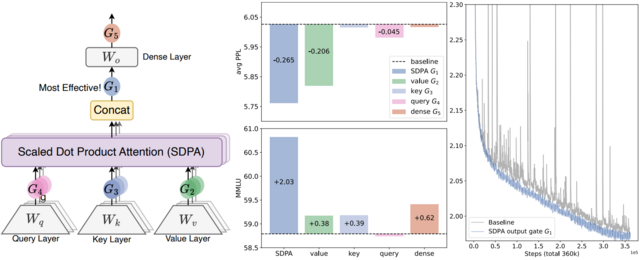
- INT v.s. FP: A Comprehensive Study of Fine-Grained Low-bit Quantization Formats (https://arxiv.org/abs/2510.25602). A comprehensive study on fine-grained, low-bit quantization formats challenges the current industry shift toward floating-point (FP) formats. The authors provide an in-depth analysis of quantization error using both theoretical Gaussian data and experimental training tensors, revealing a critical crossover point: floating-point formats are preferable for handling the high crest factors typical of coarse-grained quantization, whereas integer formats excel when crest factors are low, a condition common in fine-grained, block-wise quantization. Validating this insight across 12 diverse LLMs for direct-cast inference, the experiments consistently conclude that MXINT8 is superior to MXFP8 in accuracy and that NVINT4 can surpass NVFP4 when paired with outlier suppression techniques like Hadamard rotation. Furthermore, training experiments conducted with 1B and 3B Llama-3-style models demonstrate the superiority of MXINT8 over MXFP8, achieving nearly the same average accuracy across six common-sense reasoning tasks as standard BF16 training. The code: https://github.com/ChenMnZ/INT_vs_FP
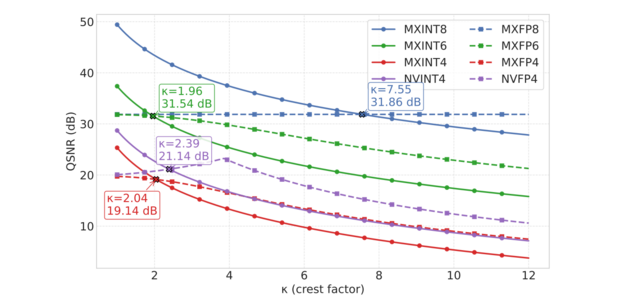
Pruning / Sparsity
- Sparse VideoGen2: Accelerate Video Generation with Sparse Attention via Semantic-Aware Permutation (https://arxiv.org/pdf/2505.18875). SVG2 is a training-free sparse attention method designed to accelerate video generation in DiT-based models. Its core idea is to use semantic-aware permutation to better identify critical tokens and reduce unnecessary sparse-attention overhead. The method introduces three key techniques:
- Semantic-aware permutation: k-means clustering is applied to the Q/K/V vectors of each head and layer, and tokens are permuted by cluster to form semantically coherent blocks, improving the accuracy of critical-token detection.
- Dynamic top-p critical-token selection: Cluster centroids approximate attention scores, and clusters (and their tokens) are selected until the cumulative probability reaches p, enabling dynamic compute budgeting.
- Customized sparse-attention kernels: Since semantic-aware clusters vary naturally in size, custom kernels are used to support dynamic block sizes, which fixed-size sparse kernels cannot handle efficiently.

Notable results
Quantization
- WUSH: Near-Optimal Adaptive Transforms for LLM Quantization (https://arxiv.org/pdf/2512.00956). This work introduces WUSH, a method that derives optimal blockwise transforms for joint weight-activation quantization in large language models. WUSH consistently reduces quantization loss and improves LLM accuracy across MXFP4 and NVFP4 formats compared to the Hadamard transform across various LLM architectures (e.g., Llama-3.2-3B, Qwen3-14B). This comes at the cost of increased inference overhead, since WUSH computes a unique, data-dependent transform for each block, rather than reusing a single fixed Hadamard transform across all blocks.

- STaMP: Sequence Transformation and Mixed Precision for Low-Precision Activation Quantization (https://arxiv.org/abs/2510.26771). STaMP is a post-training quantization technique designed to enhance the accuracy of low-bit activation quantization in large generative models by exploiting correlations along the sequence dimension rather than just the feature dimension. It combines invertible linear transformations—such as the Discrete Wavelet Transform (DWT) or Discrete Cosine Transform (DCT)—with mixed-precision quantization to concentrate the majority of activation energy into a small subset of tokens. These high-energy tokens are preserved at higher bit depths (e.g., 8-bit), while the remaining tokens are quantized to lower precision (e.g., 4-bit). The approach reduces quantization error more effectively than uniform bit allocation, especially under aggressive 4-bit constraints, and works synergistically with existing methods like SmoothQuant or QuaRot that operate on feature axes. Crucially, because the sequence transformation is orthogonal and linear, its inverse can often be merged with downstream operations such as bias addition or matrix multiplication, resulting in negligible additional computational cost during inference. The method requires no retraining and has been shown to improve both language and vision models consistently across benchmarks.

- KVLinC: KV CACHE QUANTIZATION WITH HADAMARD ROTATION AND LINEAR CORRECTION (https://arxiv.org/pdf/2510.05373v1). KVLinC is a framework designed to mitigate attention errors arising from KV cache quantization. The authors integrate two complementary techniques to enable robust low-precision caching. First, through a detailed analysis of Hadamard rotation-based quantization strategies, they show that applying channel-wise quantization to raw keys and token-wise quantization to Hadamard-transformed values minimizes quantization error. Second, to address residual errors from quantized keys, they propose lightweight linear correction adapters that explicitly learn to compensate for distortions in attention. Extensive evaluation across the Llama, Qwen2.5, and Qwen3 model families demonstrates that KVLinC consistently matches or surpasses strong baselines under aggressive KV-cache compression. Finally, the authors develop a custom attention kernel that delivers up to 2.55× speedup over FlashAttention, enabling scalable, efficient, and long-context LLM inference.
- DartQuant: Efficient Rotational Distribution Calibration for LLM Quantization(https://arxiv.org/pdf/2511.04063). DartQuant introduces an efficient method for quantizing large language models (LLMs). Instead of relying on computationally expensive end-to-end fine-tuning of rotation matrices—as done in methods like SpinQuant and OSTQuant—DartQuant eliminates the need for task-specific losses and instead optimizes activation distributions to be more uniform, using a novel loss function called Whip loss. This approach reduces the impact of extreme outliers in activations, which are a major source of quantization error, by reshaping the distribution from a Laplacian-like form toward a uniform one within a bounded range. To further reduce overhead, DartQuant proposes QR-Orth, an optimization scheme that leverages QR decomposition to enforce orthogonality on rotation matrices without requiring complex manifold optimizers like Cayley SGD. This cuts the computational cost of rotation calibration by 47× and memory usage by 10× on a 70B model, enabling full rotational calibration on a single consumer-grade RTX 3090 GPU in under 3 hours. The method maintains or slightly improves upon state-of-the-art quantization accuracy across multiple LLMs (Llama-2, Llama-3, Mixtral, DeepSeek-MoE) and evaluation benchmarks, including zero-shot reasoning tasks and perplexity metrics, while being robust to different calibration datasets and sample sizes. The code: https://github.com/CAS-CLab/DartQuant

Pruning / Sparsity
- SparseVILA: Decoupling Visual Sparsity for Efficient VLM Inference (https://arxiv.org/pdf/2510.17777). SparseVILA addresses the scalability limitations of Vision Language Models (VLMs) caused by the high computational cost of processing extensive visual tokens in long-context tasks. The framework introduces a decoupled sparsity paradigm that applies distinct optimization strategies to the prefill and decoding stages of inference. During the prefill phase, the model employs query-agnostic pruning to remove redundant visual data based on salience, efficiently creating a compact shared context. In contrast, the decoding phase utilizes query-aware retrieval to dynamically select only the specific visual tokens relevant to the current text query from the cache. This design preserves the integrity of multi-turn conversations by retaining a comprehensive visual cache, allowing different tokens to be retrieved for subsequent questions without permanent information loss. Experimental results demonstrate that SparseVILA achieves up to 2.6x end-to-end speedups on long-context video tasks while maintaining or improving accuracy across various image and reasoning benchmarks.
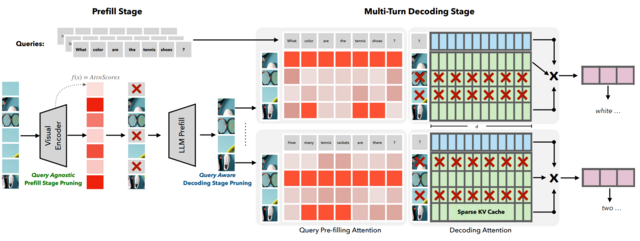
- THINKV: THOUGHT-ADAPTIVE KV CACHE COMPRESSION FOR EFFICIENT REASONING MODELS (https://arxiv.org/pdf/2510.01290v1). ThinKV is a KV cache compression framework for Large Reasoning Models (LRMs) on tasks like coding and mathematics. It classifies CoT tokens into Reasoning (R), Execution (E), and Transition (T) based on attention sparsity (T > R > E) using an offline calibration phase with Kernel Density Estimation to determine sparsity thresholds. The framework employs two main strategies:
- Think Before You Quantize: assigns token precision by importance. R/E tokens use 4-bit NVFP4, T tokens use 2-bit ternary, with group quantization (g=16) and shared FP8 (E4M3) scales; keys are quantized per-channel, values per-token. Outlier Transition thoughts are recognized as vital for backtracking and preventing model loops. Token importance is measured via KL divergence of the final answer distribution when a thought segment is removed.
- Think Before You Evict: a thought-adaptive eviction scheme aligned with PagedAttention. K-means clustering on post-RoPE key embeddings retains cluster centroids and corresponding values for evicted segments.

Caching
- LeMiCa: Lexicographic Minimax Path Caching for Efficient Diffusion-Based Video Generation (https://arxiv.org/pdf/2511.00090). LeMiCa is a novel, training-free, and efficient acceleration framework for diffusion-based video generation. The key idea is to take a global view of caching error using a Global Outcome-Aware error metric, which measures the impact of each cache segment on the final output. This approach removes temporal heterogeneity and mitigates error propagation. Using this metric, LeMiCa builds a Directed Acyclic Graph (DAG) in which each edge represents a potential cache segment, weighted by its global impact on output quality. The DAG is generated offline using multiple prompts and full sampling trajectories. LeMiCa then applies lexicographic minimax optimization to choose the path that minimizes worst-case degradation. Among all feasible paths under a fixed computational budget, it selects the one with the smallest maximum error. LeMiCa-slow achieves the highest reconstruction quality, reducing LPIPS from 0.134 → 0.05 on Open-Sora and 0.195 → 0.091 on Latte—over 2× improvement compared to TeaCache-slow. LeMiCa-fast improves inference speed from 2.60× → 2.93× on Latte relative to TeaCache-fast, while preserving visual quality. Unlike prior work that relies on online greedy strategies, LeMiCa precomputes its caching policy, eliminating runtime overhead. Code: https://unicomai.github.io/LeMiCa.

- CacheDiT: A PyTorch-native and Flexible Inference Engine with Hybrid Cache Acceleration and Parallelism for 🤗 DiTs (https://github.com/vipshop/cache-dit). It provides a unified cache API that supports features like automatic block adapters, DBCache, and more, covering almost all Diffusers' DiT-based pipelines. DBCache is a training-free Dual Block Caching mechanism inspired by the U-Net architecture. It splits the DiT Transformer block stack into three functional segments:
- Probe (front): performs full computation to capture residual signals and compare them with the previous step.
- Cache (middle): skips computation and reuses cached outputs when residual changes stay below a configurable threshold.
- Corrector (rear): always recomputes to refine outputs and correct any accumulated deviations. This probe → decision → correction loop enables structured, reliable caching that can be applied across DiT models without any retraining.

Inference
- vLLM-Gaudi - First Production-Ready vLLM Plugin for Intel® Gaudi® (https://docs.vllm.ai/projects/gaudi/en/v0.11.2/). Fully aligned with upstream vLLM, it enables efficient, high-performance large language model (LLM) inference on Intel® Gaudi®.
Compilation
- KernelFalcon: Autonomous GPU Kernel Generation via Deep Agents (https://pytorch.org/blog/kernelfalcon-autonomous-gpu-kernel-generation-via-deep-agents/). A deep agent architecture for generating GPU kernels that combines hierarchical task decomposition and delegation, a deterministic control plane with early-win parallel search, grounded tool use, and persistent memory/observability. KernelFalcon is the first known open agentic system to achieve 100% correctness across all 250 L1/L2/L3 KernelBench tasks.
Q3'25: Technology Update – Low Precision and Model Optimization
Authors
Nikolay Lyalyushkin, Liubov Talamanova, Alexander Suslov, Souvikk Kundu, Andrey Anufriev.
Summary
During Q3 2025, substantial progress was made across several fronts in efficient LLM inference — particularly in low-precision weight quantization, KV-cache eviction and compression, attention reduction through sparse and hybrid architectures, and architecture-aware optimization for State Space Models and Mixture-of-Experts. Notably, compression methods began to see adoption for FP4 formats, extending beyond traditional integer quantization, and numerous studies show that advanced KV-cache optimizations push the state of the art, achieving order-of-magnitude memory savings and notable speedups.
Highlights
- Bridging the Gap Between Promise and Performance for Microscaling FP4 Quantization (https://arxiv.org/pdf/2509.23202). The authors provide a rigorous analysis of FP4 microscaling formats (MXFP4 and NVFP4) for LLM quantization, introduce Micro-Rotated-GPTQ (MR-GPTQ) and the QuTLASS GPU kernels to bridge the performance gap for such formats. The method uses MSE-optimized grids, static activation reordering, and fused online Hadamard rotations to recover 98-99% of FP16 accuracy while achieving up to 4x inference speedups on modern GPUs. Key insights from the analysis include:
- The effectiveness of Hadamard transforms depends on the quantization group size; while they are beneficial for MXFP4 and INT4, they can actually degrade NVFP4 accuracy.
- MR-GPTQ consistently improves the accuracy of the lower-performing MXFP4 format, bringing it within 1-2% of NVFP4's performance.
- On average, NVFP4 and INT4 (with group size 32) offer similar quality.
- MXFP4 kernels may achieve ~15% higher throughput than NVFP4 on B200 GPUs, likely due to simpler hardware implementation.
The code available at: https://github.com/IST-DASLab/FP-Quant.

- Radial Attention: O(n log n) Sparse Attention with Energy Decay for Long Video Generation (https://arxiv.org/pdf/2506.19852). The paper "Radial Attention" introduces a sparse attention mechanism to optimize long video generation. Its core method reduces computational complexity from O(n2) to O(nlogn) using a static mask inspired by "Spatiotemporal Energy Decay," where attention focuses on spatially and temporally closer tokens. This architecture is highly optimized for inference. It delivers up to a 3.7x speedup on extended-length videos compared to standard dense attention, without any discernible loss in visual quality. For a concrete 500-frame, 720p video, the mechanism slashes the raw attention computation by a factor of 9x. The industrial impact is significant. Designed as a "plug-and-play" module, Radial Attention can be integrated into powerful pre-trained models like Wan2.1-14B and HunyuanVideo through efficient LoRA-based fine-tuning.

- Expected Attention: KV Cache Compression by Estimating Attention from Future Queries Distribution (https://arxiv.org/pdf/2510.00636). Expected Attention is a training-free KV cache compression method for LLMs that does not rely on observed attention scores, making it compatible with FlashAttention, where attention matrices are never materialized. It estimates the importance of cached key–value pairs by predicting how future queries will attend to them. Since hidden states before attention and MLP layers are empirically Gaussian-like, the method can analytically compute expected attention scores for each KV pair and rank them by importance for pruning. During decoding, Expected Attention maintains a small buffer of 128 hidden states to estimate future query statistics and performs compression every 512 generation steps. On LLaMA-3.1-8B, it achieves substantial memory savings—up to 15 GB reduction for 120k-token contexts. At a 50% compression ratio, Expected Attention maintains near-identical performance to the uncompressed baseline, effectively halving KV cache size while preserving output quality. Code: https://github.com/NVIDIA/kvpress
-
Papers with notable results
Quantization
- SINQ: Sinkhorn-Normalized Quantization for Calibration-Free Low-Precision LLM Weights (https://arxiv.org/pdf/2509.22944). The authors introduce a novel data-free post-training quantization method - SINQ. Instead of the traditional single-scale approach, SINQ employs dual scales: one for rows and another for columns. The method adapts the Sinkhorn-Knopp algorithm to normalize the standard deviations of matrix rows and columns. The algorithm is lightweight - operates at only 1.1x the runtime of basic RTN. The method proves robust across model scales, from small 0.6B parameter models to massive 235B parameter Mixture-of-Experts architectures. SINQ demonstrates orthogonality to other quantization advances. When combined with non-uniform quantization levels (NF4) or activation-aware calibration (A-SINQ with AWQ), it provides additional improvements.

- 70% Size, 100% Accuracy: Lossless LLM Compression for Efficient GPU Inference via Dynamic-Length Float (https://arxiv.org/pdf/2504.11651). The paper presents DFloat11, a dynamic-length float encoding scheme that exploits the low entropy of BFloat16 weights in large language models to achieve ~30% storage savings (reducing from 100% to ~70% size) without any loss in accuracy (bit-for-bit identical outputs). They do this by frequency-based variable-length coding of weight values, and couple it with a custom GPU decompression kernel allowing efficient inference. Experiments on large LLMs show major throughput gains and extended context length under fixed GPU memory budgets, making deployment more practical on resource-constrained hardware.
- XQUANT: Breaking the Memory Wall for LLM Inference with KV Cache Rematerialization (https://arxiv.org/pdf/2508.10395). This paper introduces XQuant, a memory-efficient LLM inference method that quantizes and caches input activations (X) of each transformer layer instead of Key-Value pairs. During inference, K and V are rematerialized on-the-fly by multiplying the cached X with the projection matrices, halving the memory footprint compared to standard KV caching. XQuant uses uniform low-bit quantization for X, which is more robust to aggressive quantization than K/V, enabling high compression with minimal accuracy loss. Building on this, XQuant-CL exploits cross-layer similarity in X embeddings by compressing the differences between successive layers, which have a smaller dynamic range due to the transformer's residual stream. Both XQuant and XQuant-CL outperform state-of-the-art KV cache quantization methods like KVQuant, while retaining accuracy close to the FP16 baseline. For GQA models, X is down-projected via offline SVD into a smaller latent space, preserving memory efficiency and accuracy. On LLaMA-2-7B and LLaMA-2-13B, XQuant achieves 7.7× memory savings with <0.1 perplexity degradation, while XQuant-CL reaches 12.5× savings at 2-bit precision (0.1 perplexity degradation) and 10× savings at 3-bit precision (0.01 perplexity degradation).
- Quamba2: A Robust and Scalable Post-training Quantization Framework for Selective State Space Models (https://arxiv.org/pdf/2503.22879). State Space Models (SSMs) are highly sensitive to quantization due to their linear recurrence process, which magnifies even minor numerical perturbations, making traditional Transformer quantization methods ineffective. The authors identify several distinctive properties of SSMs: (1) the input and output channel orders remain consistent, and (2) the activated channels and states are stable across time steps and input variations. Leveraging these insights, they propose Quamba2, a post-training quantization framework specifically tailored for SSMs. Quamba2 utilizes these properties through three key strategies: an offline sort-and-cluster process for input quantization, per-state-group quantization for input-dependent parameters, and cluster-aware weight reordering. The approach supports multiple precision configurations—W8A8, W4A8, and W4A16—across both Mamba1 and Mamba2 architectures. Empirical results show that Quamba2 surpasses existing SSM quantization methods on zero-shot and MMLU benchmarks. It achieves up to 1.3× faster pre-filling, 3× faster generation, and 4× lower memory usage on models such as Mamba2-8B, with only a 1.6% average accuracy drop. Code is available at https://github.com/enyac-group/Quamba.

- Qronos: Correcting the Past by Shaping the Future... in Post-Training Quantization (https://arxiv.org/pdf/2505.11695). The paper introduces Qronos, a new state-of-the-art post-training quantization (PTQ) algorithm for compressing LLMs. Its core innovation is that it unifies two critical error-handling strategies for the first time: it corrects for the "inherited" error propagated from previous layers and the "local" error from weights quantization within the current layer. This dual approach yields state-of-the-art results for small LLMs like Llama3-1B/3B/8B models. It can serve as a drop-in replacement for existing methods like GPTQ, running efficiently on resource-constrained hardware like AI laptops.

- Quantization Hurts Reasoning? An Empirical Study on Quantized Reasoning Models (https://arxiv.org/pdf/2504.04823). This paper conducts a systematic study on quantized reasoning models, evaluating the open-sourced DeepSeek-R1-Distilled Qwen and LLaMA families ranging from 1.5B to 70B params, QwQ-32B, and Qwen3-8B. The authors conducted quantization for weights, KV cache, and activation tensors. They claim that W8A8 or W4A16 may be treated as a form of lossless quantization. Specifically, for weights with 8-bit nearly all the quantization types generally lead to lossless accuracy, with no clear leading algorithm. While at 4-bit, FlatQuant emerges as a preferred algorithm and can yield near-lossless performance for the weight-only quantization scenario. For KV cache, the authors suggested 4-bit quantization as a safer choice, as at lower precision the models suffer from significant accuracy drop. Additionally, the authors claim that quantization may make more critical tasks more prone to error, with extreme low-precision models often generating longer sequences, hinting at longer thinking scenario. The code is available at: https://github.com/ruikangliu/Quantized-Reasoning-Models.
Pruning/Sparsity
- PagedEviction: Structured Block-wise KV Cache Pruning for Efficient Large Language Model Inference (https://arxiv.org/pdf/2509.04377). The authors propose PagedEviction, a structured block-wise KV cache eviction strategy designed for vLLM’s PagedAttention to enhance memory efficiency during large language model inference. The method computes token importance using the ratio of the L2 norm of Value to Key tokens, avoiding the need to store attention weights for compatibility with FlashAttention. It evicts an entire block only when the current block becomes full, reducing fragmentation and minimizing per-step eviction overhead. PagedEviction achieves high compression efficiency with minimal accuracy loss, significantly outperforming prior methods on long-context tasks. For example, it improves ROUGE scores by 15–20% over StreamingLLM and KeyDiff at tight cache budgets while closely matching full-cache performance at larger budgets across LLaMA-3.2-1B-Instruct and 3B-Instruct models.
- REAP: One-Shot Pruning for Trillion-Parameter Mixture-of-Experts Models (https://arxiv.org/pdf/2510.13999). The authors show that merging experts introduces an irreducible error and substantially reduces the functional output space of the compressed SMoE layer. Leveraging this insight, they propose Router-weighted Expert Activation Pruning (REAP), a one-shot pruning method that removes low-impact experts while preserving model quality. REAP assigns each expert a saliency score that combines its router gate-values with its average activation norm, effectively identifying experts that are rarely selected and have minimal influence on the model’s output. Across sparse MoE architectures from 20B to 1T parameters, REAP consistently outperforms prior pruning and merging methods, particularly at 50% compression. It achieves near-lossless compression on code generation tasks, retaining performance after pruning 50% of experts from Qwen3-Coder-480B and Kimi-K2. Code is available at: https://github.com/CerebrasResearch/reap.
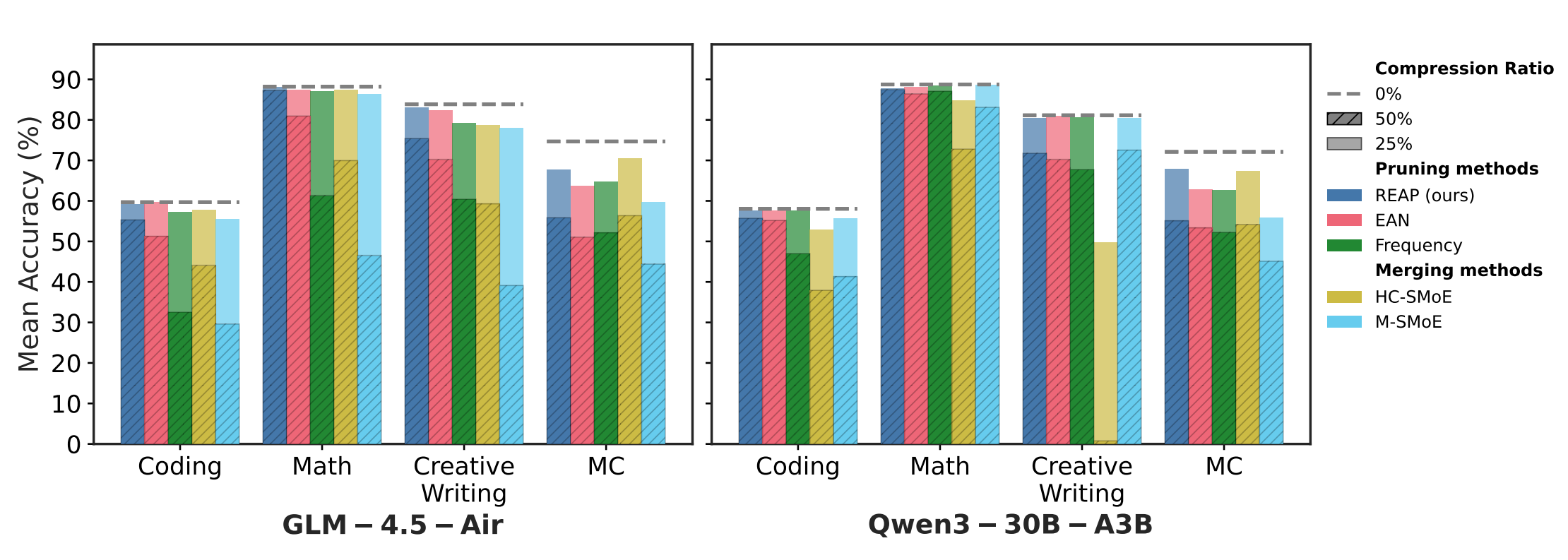
- The Unseen Frontier: Pushing the Limits of LLM Sparsity with Surrogate-Free ADMM (https://arxiv.org/pdf/2510.01650). This paper tackles the limitation of existing pruning methods for large language models, which struggle to exceed 50–60% sparsity without severe performance loss. The authors attribute this to the use of indirect objectives, such as minimizing layer-wise reconstruction errors, which accumulate mistakes and lead to suboptimal outcomes. To address this, the proposed method, ELSA, directly optimizes the true task objective — minimizing loss on actual downstream tasks — rather than relying on surrogate goals. It leverages the ADMM framework, a proven mathematical technique that decomposes complex problems into simpler alternating steps, to guide the pruning process while maintaining alignment with the model’s real objectives. A lightweight variant, ELSA-L, further improves scalability by using lower-precision data formats, enabling efficient pruning of even larger models. ELSA achieves 7.8× lower perplexity than the best existing method on LLaMA-2-7B at 90% sparsity. Although some accuracy loss remains, this represents a major breakthrough, and the authors argue that improved global optimization, like their approach, could further narrow this gap.
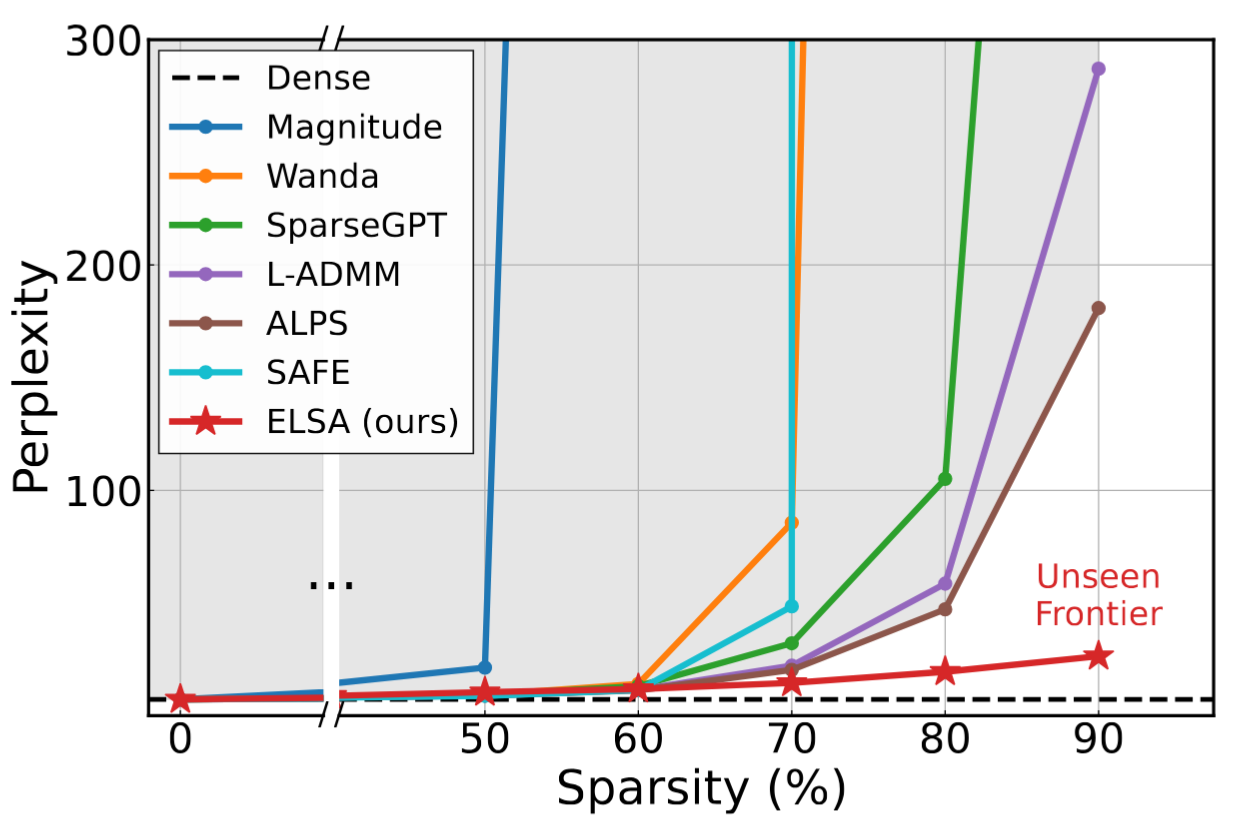
Other
- Top-H Decoding: Adapting the Creativity and Coherence with Bounded Entropy in Text Generation (https://openreview.net/pdf/0b494e52bae7fe34f7af35e0d5bfa6bd0dcb39b8.pdf). Toward effective incorporation of the confidence of the model while generating tokens, the authors propose top-H decoding. The authors first establish the theoretical foundation of the interplay between creativity and coherence in truncated sampling by formulating an entropy-constrained minimum divergence problem. Then they prove this minimization problem to be equivalent to an entropy-constrained mass maximization (ECMM) problem, which is NP-hard. Finally, the paper presents top-H decoding, a computationally viable greedy algorithmic approximation to solve the ECMM problem. Extensive empirical evaluations demonstrate that top-H outperforms the state-of-the-art (SoTA) alternative of min-p sampling by up to 25.63% on creative writing benchmarks, while maintaining robustness on question-answering datasets such as GPQA, GSM8K, and MT-Bench. Additionally, an LLM-as-judge evaluation confirms that top-H indeed produces coherent outputs even at higher temperatures, where creativity is especially critical. In summary, top-H advances SoTA in open-ended text generation and can be easily integrated into creative writing applications. The code is available at: https://github.com/ErfanBaghaei/Top-H-Decoding.
- Stop Spinning Wheels: Mitigating LLM Overthinking via Mining Patterns for Early Reasoning Exit (https://arxiv.org/pdf/2508.17627). The authors introduce a lightweight framework to detect and terminate reasoning at the optimal Reasoning Completion Point (RCP), preventing unnecessary token generation in large reasoning models. They categorize the reasoning process of LLMs into three stages: insufficient exploration, compensatory reasoning, and reasoning convergence. Typically, LLMs produce correct answers during the compensatory reasoning stage, while the reasoning convergence stage often triggers overthinking, leading to excessive resource usage or even infinite loops. The RCP is defined as the boundary marking the end of the compensatory reasoning stage and typically appears at the end of the first complete reasoning cycle, beyond which additional reasoning offers no accuracy gain. To balance efficiency and accuracy, the authors distilled insights from CatBoost feature importance analysis into a concise and effective set of stepwise heuristic rules. Experiments on benchmarks such as AIME24, AIME25, and GPQA-D demonstrate that the proposed strategy reduces token consumption by over 30% while maintaining or improving reasoning accuracy.

- A Systematic Analysis of Hybrid Linear Attention (https://arxiv.org/pdf/2507.06457). This work systematically analyzes hybrid linear attention architectures to balance computational efficiency with long-range recall in large language models. The authors construct hybrid models by interleaving linear and full attention layers at varying ratios (24:1, 12:1, 6:1, 3:1) to analyze their impact on performance and efficiency. The key insight is that gating, hierarchical recurrence, and controlled forgetting mechanisms are critical to achieve Transformer-level recall in hybrid architectures when deployed at a 3:1 to 6:1 linear-to-full attention ratio, reducing KV cache memory by a factor of 4-7x.
- Gumiho: A Hybrid Architecture to Prioritize Early Tokens in Speculative Decoding (https://arxiv.org/pdf/2503.10135). The authors deliver a new Speculative Decoding (SD) method for accelerating Large Language Model (LLM) inference. This is an incremental improvement of the Eagle SD method from NVIDIA. Its core insight is that early tokens in a speculative decoding draft are disproportionately more important than later ones. The paper introduces a novel hybrid architecture to exploit this: a high-accuracy serial Transformer for the crucial first tokens and efficient parallel MLPs for subsequent ones. Gumiho surpasses the existing SOTA method EAGLE-2 by 4.5%∼15.8%, but does not have a comparison with EAGLE-3. The code: https://github.com/AMD-AGI/Gumiho
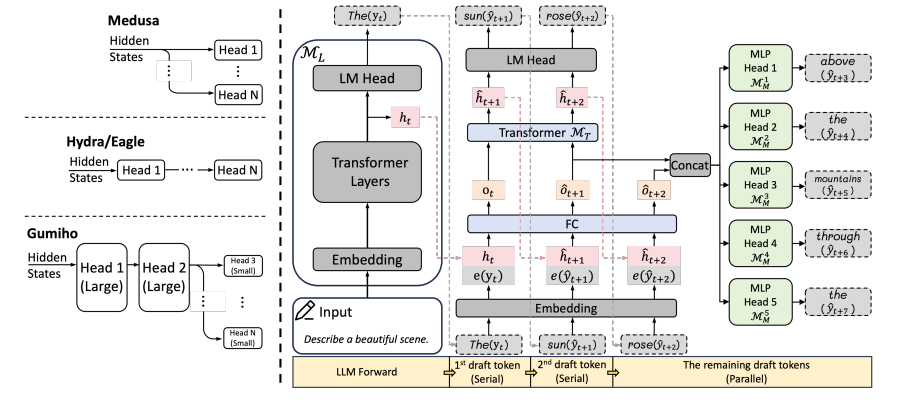
Software
- OptiLLM (https://github.com/algorithmicsuperintelligence/optillm) is an OpenAI API-compatible optimizing inference proxy that implements 20+ state-of-the-art techniques to dramatically improve LLM accuracy and performance on reasoning tasks - without requiring any model training or fine-tuning. It is possible to beat the frontier models using these techniques across diverse tasks by doing additional compute at inference time.
- FlashDMoE (https://flash-moe.github.io): Fast Distributed MoE in a Single Kernel - a fully GPU-resident MoE operator that fuses expert computation and inter-GPU communication into a single persistent GPU kernel. FlashDMoE enables fine-grained pipelining of dispatch, compute, and combine phases, eliminating launch overheads and reducing idle gaps.
- LMCache (https://github.com/LMCache/LMCache) is an LLM serving extension that cuts TTFT and boosts throughput in long-context scenarios. By storing the KV caches of reusable texts across various locations, including (GPU, CPU DRAM, Local Disk), LMCache reuses the KV caches of any reused text (not necessarily prefix) in any serving engine instance. Integrated with vLLM, LMCache delivers 3–10× faster responses and lower GPU usage in tasks like multi-round QA and RAG.
- Flash Attention 4 (FA4) is a newly developed CUDA kernel optimized for Nvidia’s Blackwell architecture, delivering roughly a 20% performance improvement over previous versions. It achieves this speedup through an asynchronous pipeline of operations and several mathematical optimizations, including a fast exponential approximation and a more efficient online softmax. Tri Dao presented early results of FA4 at Hot Chips, and further implementation details were later shared in a blog post: https://modal.com/blog/reverse-engineer-flash-attention-4.
Q2'25: Technology Update – Low Precision and Model Optimization
Authors
Alexander Suslov, Alexander Kozlov, Nikolay Lyalyushkin, Nikita Savelyev, Souvikk Kundu, Andrey Anufriev, Pablo Munoz, Liubov Talamanova, Daniil Lyakhov, Yury Gorbachev, Nilesh Jain, Maxim Proshin, Evangelos Georganas
Summary
This quarter marked a major shift towards efficiency in large-scale AI, driven by the unsustainable computational and memory costs of current architectures. The focus is now on making models dramatically faster and more hardware-friendly, especially for demanding long-context and multimodal tasks. 🚀 There is a growing adoption of dynamic, data-aware techniques like dynamic sparse attention and token pruning, which intelligently reduce computation by focusing only on the most critical information. Furthermore, optimization is increasingly tailored to new hardware through ultra-low precision; quantization is being pushed to the extreme, with native 1-bit (BitNet) inference and 4-bit (FP4) training becoming viable by aligning directly with new GPU capabilities.
A parallel trend is the creation of simple, readable frameworks like Nano-vLLM, whose lightweight design aims to lower the barrier to entry for developers and researchers.
Highlights
- MMInference: Accelerating Pre-filling for Long-Context Visual Language Models via Modality-Aware Permutation Sparse Attention (https://arxiv.org/pdf/2502.02631). The authors introduce MMInference (Multimodality Million tokens Inference), a dynamic sparse attention method that accelerates the prefilling stage for long-context multi-modal inputs. The core ideas stemfrom analyzing the attention patterns specific to multi-modal inputs in VLMs: (1) Visual inputs exhibit strong temporal and spatial locality, leading to a unique sparse pattern the authors term the "Grid pattern".(2) Attention patterns differ significantly within a modality versus across modalities. The authors introduces the permutation-based method for offline searching the optimal sparse patterns for each head based on the input andoptimized kernels to compute attention much faster. MMInference speeds up the VLM pre-filling stage by up to 8.3x (at 1 million tokens) without losing accuracy and without needing any model retraining.The paper demonstrates maintained performance across various multi-modal benchmarks (like Video QA and Captioning) using state-of-the-art models (LongVila, LlavaVideo, VideoChat-Flash, Qwen2.5-VL). The code is available at https://aka.ms/MMInference.
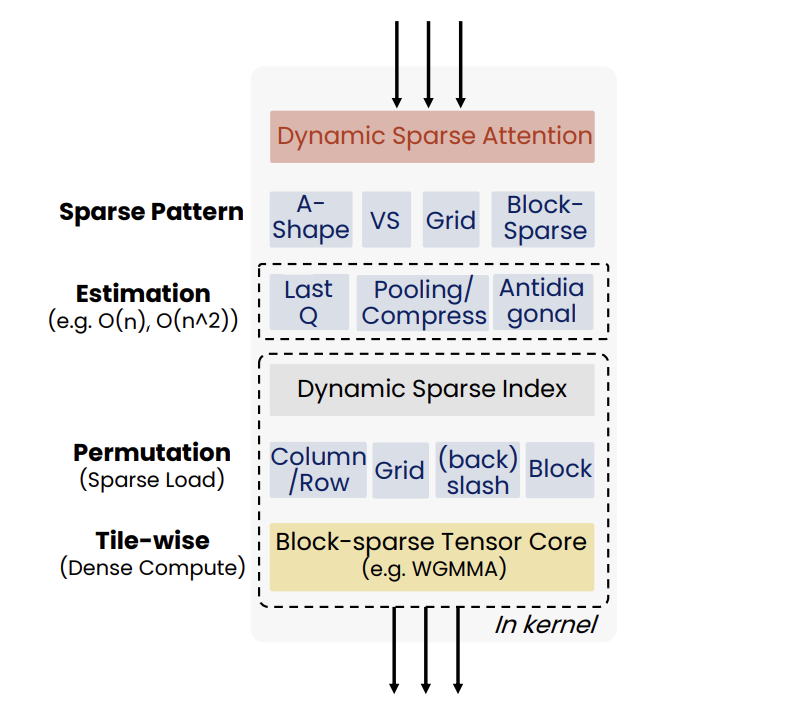
- Beyond Text-Visual Attention: Exploiting Visual Cues for Effective Token Pruning in VLMs (https://arxiv.org/pdf/2412.01818). The authors introduce VisPruner, a training-free method for compressing visual token sequences in VLMs, dramatically reducing computational overhead. Unlike prior approaches that rely on text-visual attention scores - often biased and dispersed - VisPruner leverages visual cues directly from the visual encoder. They identify two key flaws in attention-based pruning: (1) attention shift: positional bias causes attention to favor lower image regions (tokens closer to the text in sequence); (2) attention dispersion: attention is spread too uniformly, making it hard to identify important tokens. VisPruner first selects a small set of important tokens using [CLS] attention (typically focused on foreground objects), then complements them with diverse tokens selected via similarity-based filtering to preserve background and contextual information. This visual-centric pruning strategy avoids reliance on language model internals and is compatible with fast attention mechanisms like FlashAttention. VisPruner outperforms finetuning-free baselines like FastV, SparseVLM, and VisionZip across 13 benchmarks—including high-resolution and video tasks—even when retaining as little as 5% of the original visual tokens. It achieves up to 95% FLOPs reduction and 75% latency reduction.

- OuroMamba: A Data-Free Quantization Framework for Vision Mamba Models (https://www.arxiv.org/pdf/2503.10959). The authors present OuroMamba, the first data-free post-training quantization (DFQ) method for vision Mamba-based models (VMMs). The authors identify two key challenges in enabling DFQ for VMMs, (1) VMM’s recurrent state transitions restricts capturing of long-range interactions and leads to semantically weak synthetic data,(2) VMM activation exhibit dynamic outlier variations across time-steps, rendering existing static PTQ techniques ineffective. To address these challenges, OuroMamba presents a two-stage framework: (1) OuroMamba-Gen to generate semantically rich and meaningful synthetic data. It applies constructive learning on patch level VMM features generated through neighborhood interactions in the latent state space, (2) OuroMamba-Quant to employ mixed-precision quantization with lightweight dynamic outlier detection during inference. In specific, the paper presents a threshold based outlier channel selection strategy for activation that gets updated every time-step. Extensive experiments across vision and generative tasks show that our data-free OuroMamba surpasses existing data-driven PTQ techniques, achieving state-of-the-art performance across diverse quantization settings. Additionally, the authors demonstrate the efficacy via implementation of efficient GPU kernels to achieve practical latency speedup of up to 2.36×.

- TailorKV: A Hybrid Framework for Long-Context Inference via Tailored KV Cache Optimization (https://arxiv.org/pdf/2505.19586). TailorKV is a novel framework designed to optimize the KV cache in LLMs for long-context inference, significantly reducing GPU memory usage and latency without sacrificing model performance.Instead of applying a one-size-fits-all compression strategy, TailorKV intelligently tailors compression based on the characteristics of each Transformer layer. The authors look at how each layer distributes its attention across tokens: (1) If a layer spreads attention broadly across many tokens, it’s considered to be dense. These layers are good candidates for quantization, because compressing them doesn’t significantly harm performance (usually shallow layers). (2) If a layer focuses attention on just a few tokens, it’s considered to be sparse. These layers are better suited for sparse retrieval, where only the most important tokens are kept in memory (deeper layers). To make this decision, they compute a score for each layer that reflects how concentrated or spread out the attention is. If the score is above a certain threshold, the layer is labeled quantization-friendly; otherwise, it’s considered sparsity-friendly. This classification is done offline, meaning it’s calculated once before inference, so it doesn’t affect runtime performance. TailorKV drastically reduces memory usage by quantizing 1 to 2 layers to 1-bit precision and loading only 1% to 3% of the tokens for the remaining layers.Maintains high accuracy across diverse tasks and datasets, outperforming state-of-the-art methods like SnapKV, Quest, and PQCache on LongBench. Code is available at: https://github.com/ydyhello/TailorKV.

- Log-Linear Attention (https://arxiv.org/pdf/2506.04761). The authors present Log-Linear Attention, a general framework that extends linear attention and state-space models by introducing a logarithmic growing memory structure for efficient long-context modeling. The paper identifies two key limitations in prior linear attention architectures: (1) the use of fixed-size hidden states restricts their ability to model multi-scale temporal dependencies, and (2) their performance degrades on long sequences due to the lack of hierarchical context aggregation.To address these challenges, Log-Linear Attention places a particular structure on the attention mask, enabling the compute cost to be log-linear and the memory cost to be logarithmic in sequence length (O(TlogT) training time,O(logT) inference time and memory). Conceptually, it uses a Fenwick tree–based scheme to hierarchically partition the input into power-of-two-sized segments. Each query attends to a logarithmic number of hidden states, summarizing increasingly coarse ranges of past tokens. This design emphasizes recent context with finer granularity, while efficiently compressing distant information.The framework is instantiated on top of two representative models: Mamba-2 and Gated DeltaNet, resulting in Log-Linear Mamba-2 and Log-Linear Gated DeltaNet. These variants inherit the expressive recurrence structures of their linear counterparts but benefit from logarithmic memory growth and sub-quadratic training algorithms via a custom chunk-wise parallel scan implementation in Triton.Experiments across language modeling, long-context retrieval, and in-context reasoning benchmarks show that Log-Linear Attention consistently improves long-range recall while achieving competitive or better throughput than FlashAttention-2 at longer sequence lengths (>8K). The code is available at https://github.com/HanGuo97/log-linear-attention.
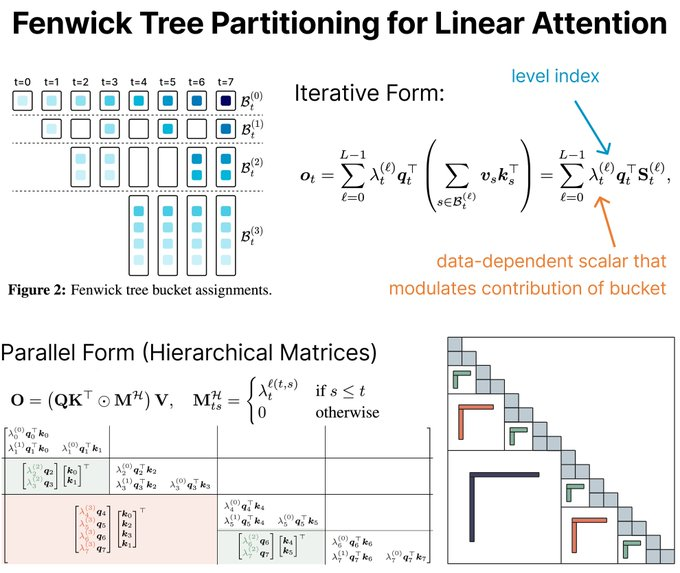
- The Sparse Frontier: Sparse Attention Trade-offs in Transformer LLMs (https://arxiv.org/pdf/2504.17768). The authors introduce SparseFrontier, a systematic evaluation of dynamic sparse attention methods aimed at accelerating inference in LLMs for long-context inputs (up to 128K tokens). The core ideas stem from an extensive analysis of sparse attention trade-offs across different inference stages, model scales, and task types: (1) Sparse attention during decoding tolerates higher sparsity than during prefilling, particularly in larger models, due to differences in memory and compute bottlenecks.(2) No single sparse pattern is optimal across all tasks - retrieval, aggregation, and reasoning tasks each require different units of sparsification (e.g., blocks vs. tokens) and budget strategies. During prefilling, the best sparsification structure (e.g., blocks or verticals and slashes) is task-dependent, with uniform allocation across layers performing comparably to dynamic allocation. During decoding, page-level Quest excels by preserving the KV cache structure, avoiding the performance degradation associated with token pruning during generation. Their FLOPS analysis shows that for long context, large sparse models outperform smaller dense ones at the same compute cost. They also establish scaling laws predicting accuracy from model size, sequence length, and compression ratio.The code is available at: https://github.com/PiotrNawrot/sparse-frontier.
Papers with notable results
Quantization
- SeedLM: Compressing LLM Weights into Seeds of Pseudo-Random Generators (https://arxiv.org/pdf/2410.10714). This paper introduces SeedLM, a novel data-free post-training compression method for Large Language Models (LLMs) that uses seeds of pseudo-random generators and some coefficients to recreate model weights. SeedLM aims to reduce memory access and leverage idle compute cycles during inference, effectively speeding up memory-bound tasks by trading compute for fewer memory accesses.The method generalizes well across diverse tasks, achieving better zero-shot accuracy retention at 4- and 3-bit compression compared to OmniQuant, AWQ and QuIP#. Additionally, FPGA-based tests demonstrate close to 4x speedup for memory-bound tasks such as generation for 4bit per value over an FP16 Llama baseline.
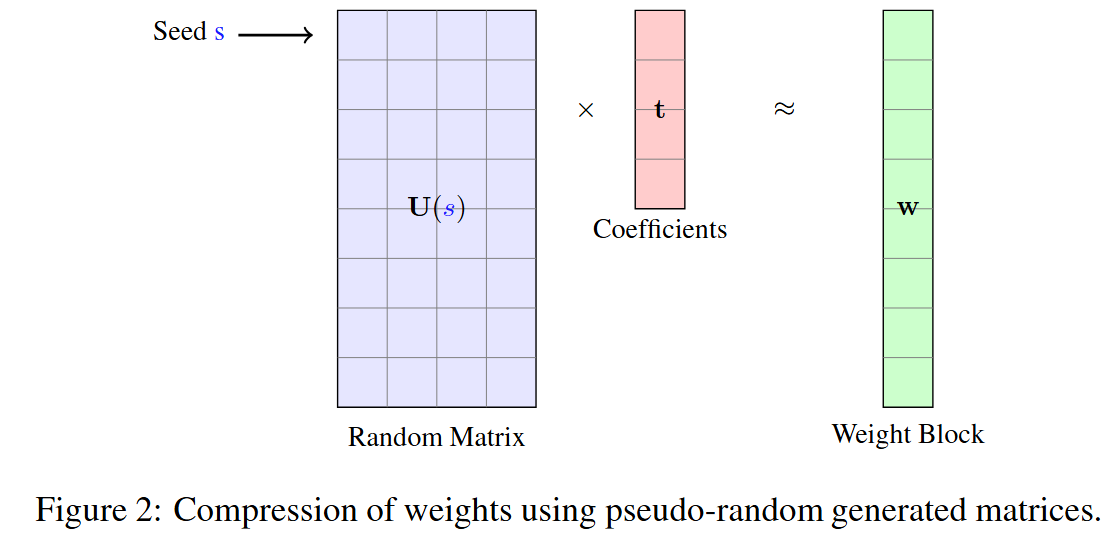
- LoTA-QAF: Lossless Ternary Adaptation for Quantization-Aware Fine-Tuning (https://arxiv.org/pdf/2505.18724). LoTA-QAF is a quantization-aware fine-tuning method for LLMs designed for efficient edge deployment. Its key innovation is a ternary adaptation approach, where ternary adapter matrices can only increment, decrement, or leave unchanged each quantized integer weight (+1, −1, or 0) within the quantization grid during fine-tuning. This tightly restricts the amount each quantized value can change, ensuring the adapters do not make large modifications to weights. The method enables lossless merging of adaptation into the quantized model, preserving computational efficiency and model performance with no quantization-induced accuracy loss at merge. The method uses a novel ternary signed gradient descent (t-SignSGD) optimizer to efficiently update these highly constrained ternary weights. Evaluated on the Llama-3.1/3.3 and Qwen-2.5 families, LoTA-QAF consistently outperforms previous quantization-aware fine-tuning methods such as QA-LoRA, especially at very low bit-widths (2-bit and 3-bit quantization), recovering up to 5.14% more accuracy on MMLU compared to LoRA under 2-bit quantization, while also being 1.7x–2x faster at inference after merging. Task-specific fine-tuning shows LoTA-QAF improves on other quantization-aware methods, though it slightly lags behind full-precision LoRA in those scenarios.The code is available at: https://github.com/KingdalfGoodman/LoTA-QAF.
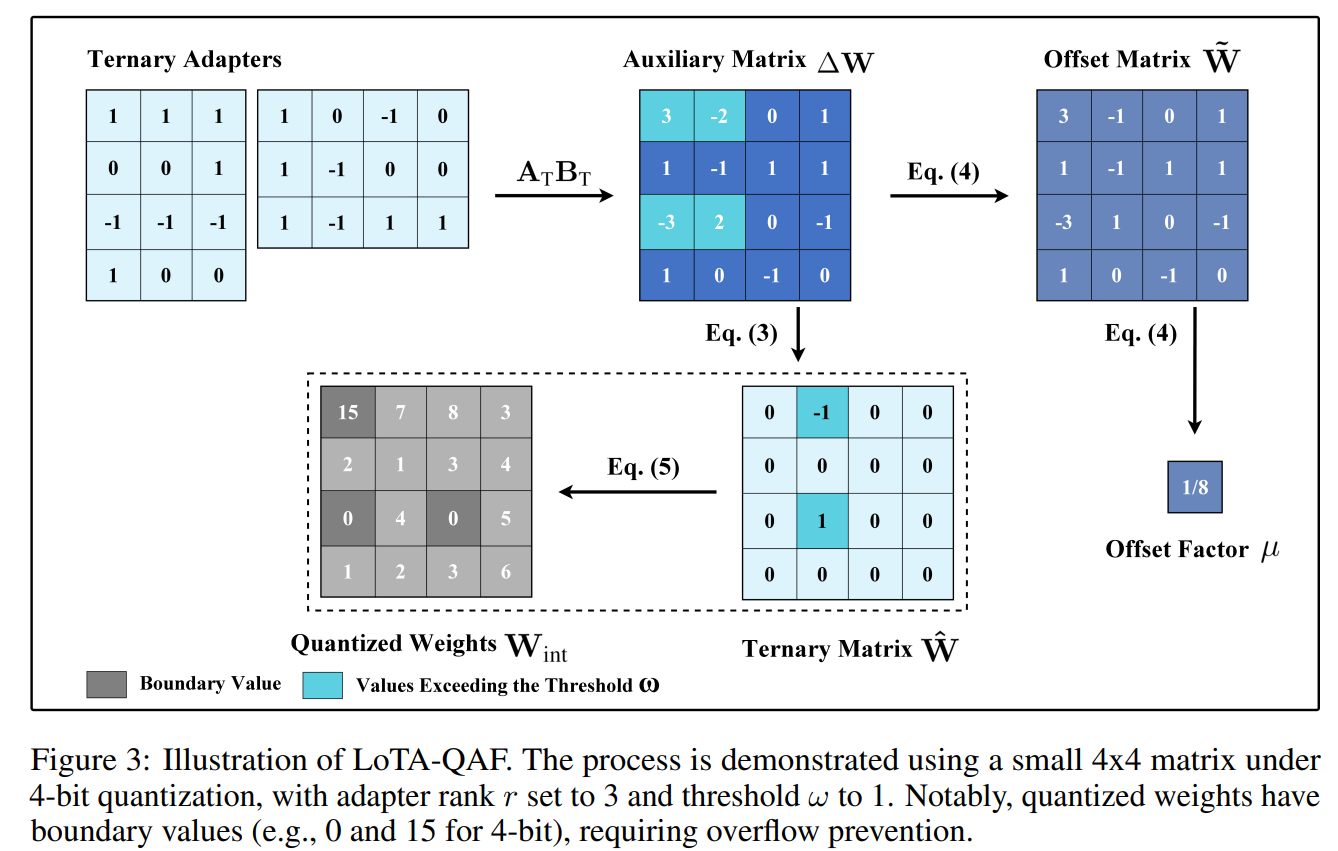
- SageAttention3: Microscaling FP4 Attention for Inference and An Exploration of 8-bit Training (https://arxiv.org/abs/2505.11594). The authors introduce SageAttention3, a novel FP4 micro-scaling quantization technique for Transformer attention designed to achieve a 5x speedup in inference on NVIDIA GPUs and an 8-bit novel training approach that preserves model accuracy during finetuning while reducing memory demands. The method applies FP4 quantization to the two main attention matrix multiplications, using a microscaling strategy with a group size of 16 elements per scale factor. This fine granularity limits the impact of outlier values that can otherwise cause significant quantization error. To address issues with quantizing the attention map, the authors propose a two-level quantization scheme. First, each row of attention map is scaled into the range[0, 448 × 6], which ensures the FP8 scaling factor (required by hardware) fully utilizes its representation range. Then, FP4 quantization is applied at the block level. This two-step process significantly reduces quantization error compared to direct quantization. Empirical results show that SageAttention3 delivers substantial inference speedups with minimal quality loss on language, image, and video generation benchmarks. The code is available at: https://github.com/thu-ml/SageAttention.

- MambaQuant: Quantizing the Mamba Family with Variance Aligned Rotation Methods (https://arxiv.org/abs/2501.13484). This paper tackles the challenge of post-training quantization for Mamba architectures. Standard quantization techniques adapted from large language models result in substantial accuracy loss when applied to Mamba models, largely due to extreme outliers and inconsistent variances across different channels in weights and activations. To address these issues, the authors propose MambaQuant, introducing two variance alignment techniques: KLT-Enhanced and Smooth-Fused rotations. These methods effectively equalize channel variances, resulting in more uniform data distributions before quantization. Experimental results show that MambaQuant enables Mamba models to be quantized to 8 bits for both weights and activations with less than 1% loss in accuracy, markedly surpassing previous approaches on both vision and language tasks.
- APHQ-ViT: Post-Training Quantization with Average Perturbation Hessian Based Reconstruction for Vision Transformers (https://arxiv.org/pdf/2504.02508). APHQ-ViT is a PTQ method designed to address the challenges of quantizing Vision Transformers, particularly under ultra-low bit settings. Traditional reconstruction-based PTQ methods, effective for Convolutional Neural Networks, often fail with ViTs due to inaccurate estimation of output importance and significant accuracy degradation when quantizing post-GELU activations. To overcome these issues, APHQ-ViT introduces an improved Average Perturbation Hessian (APH) loss for better importance estimation. Additionally, it proposes an MLP Reconstruction technique that replaces the GELU activation function with ReLU in the MLP modules and reconstructs them using the APH loss on a small unlabeled calibration set. Experiments demonstrate that APHQ-ViT, utilizing linear quantizers, outperforms existing PTQ methods by substantial margins in 3-bit and 4-bit quantization across various vision tasks. The source code for APHQ-ViT is available at https://github.com/GoatWu/APHQ-ViT.
- DL-QAT: Weight-Decomposed Low-Rank Quantization-Aware Training for Large Language Models (https://arxiv.org/abs/2504.09223). DL-QAT is a quantization-aware training (QAT) technique for LLMs that achieves high efficiency by updating less than 1% of parameters. It introduces group-specific quantization magnitudes and uses LoRA-based low-rank adaptation within the quantization space. Tested on LLaMA and LLaMA2, DL-QAT outperforms previous state-of-the-art methods—including QA-LoRA and LLM-QAT - by up to 4.2% on MMLU benchmarks for 3-bit models, while greatly reducing memory and training costs.
- BitNet b1.58 2B4T Technical Report (https://arxiv.org/abs/2504.09223). Microsoft Research released the weights for BitNet b1.58 2B4T, the first open-source, native 1-bit Large Language Model (LLM) at the 2-billion parameter scale and inference framework bitnet.cpp. The new 2B model demonstrates performance comparable to the Qwen 2.5 1.5B on benchmarks, while operating at 2x the speed and consuming 12x less energy.
- Quartet: Native FP4 Training Can Be Optimal for Large Language Models (https://arxiv.org/pdf/2505.14669). The authors introduced a new method "Quarter" for the stable 4-bit floating-point (FP4) training. There is specifically designed for the native FP4 hardware in NVIDIA's new Blackwell GPUs and achieved a nearly 2x speedup on the most intensive training computations compared to 8-bit techniques, all while maintaining "near-lossless" accuracy. The method outlines to perform a forward pass that minimizes MSE (based on QuEST) together with a backwardpass that is unbiased (based on Stochastic Rounding). The code of extremely efficient GPU-aware implementation https://github.com/IST-DASLab/Quartet
- InfiJanice: Joint Analysis and In-situ Correction Engine for Quantization-Induced Math Degradation in Large Language Models (https://arxiv.org/pdf/2505.11574). The authours investigates how quantization significantly harms the mathematical reasoning abilities of LLMs. The study reveals that quantization can degrade reasoning accuracy by up to 69.81% on complex benchmarks, with smaller models being more severely affected. Authors developed an automated pipeline to analyze and categorize the specific errors introduced by quantization. Based on these findings, they created a compact, targeted dataset named "Silver Bullet." The most notable result is that fine-tuning a quantized model on as few as 332 of these curated examples for just 3–5 minutes on a single GPU is sufficient to restore its mathematical reasoning accuracy to the level of the original, full-precision model.
Pruning/Sparsity
- Token Sequence Compression for Efficient Multimodal Computing (https://arxiv.org/pdf/2504.17892). The authors introduce a training-free method for compressing visual token sequences in visual language models (VLMs), significantly reducing computational costs. Instead of relying on attention-based “saliency”—a measure of how much attention a model gives to each token—they use simple clustering to group similar visual tokens and aggregate them. Their “Cluster & Aggregate” approach outperforms prior finetuning-free methods like VisionZip and SparseVLM across 8+ benchmarks, even when retaining as little as 11% of the original tokens. Surprisingly, random and spatial sampling also perform competitively, revealing high redundancy in visual encodings.
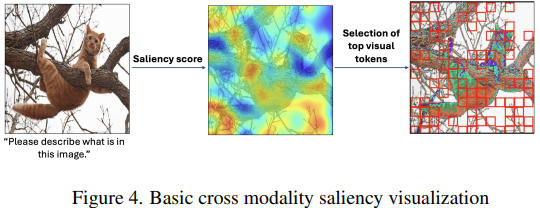
- Beyond 2:4: exploring V:N:M sparsity for efficient transformer inference on GPUs (https://arxiv.org/abs/2410.16135). This paper introduces and systematically studies V:N:M sparsity as a more efficient and flexible alternative to the industry-standard 2:4 sparsity for accelerating Transformer inference on GPUs. In the V:N:M approach, weight matrices are divided into V×M blocks; within each block, most columns are pruned, and 2:4 sparsity is then applied to the remaining columns. This scheme enables significantly higher and more adaptable sparsity ratios, while remaining compatible with existing GPU sparse tensor core acceleration. The authors propose a comprehensive framework for creating V:N:M-sparse Transformers: it features a heuristic method for selecting V and M values to optimize the accuracy-speedup trade-off, a V:N:M-specific channel permutation method for improving accuracy in low-budget training scenarios, and a three-stage LoRA training process for memory-efficient fine-tuning. Experimental results show that V:N:M-sparse Transformers can achieve much higher sparsity levels - such as 75% parameter reduction, while maintaining nearly lossless accuracy on downstream tasks, and outperform 2:4 sparsity in both speed and flexibility.

- TopV: Compatible Token Pruning with Inference Time Optimization for Fast and Low-Memory Multimodal Vision Language Model (https://arxiv.org/pdf/2503.18278v2). The authors introduce a training-free, optimization-based framework for reducing visual token redundancy in VLMs. Visual tokens often dominate the input sequence—up to 95% in some models. TopV addresses this by pruning unimportant visual tokens once during the prefilling stage, before decoding begins.Instead of relying on attention scores, TopV estimates the importance of each visual token by solving an optimal transport problem. In this setup: (1) Source tokens are the input visual tokens entering a specific transformer layer. (2) Target tokens are the output visual tokens after that layer has processed the input—specifically, the output after the Post-LN sub-layer. TopV calculates how much each input token contributes to the output using the Sinkhorn algorithm, guided by a cost function that considers: (1) How similar the tokens are in content (feature similarity), (2) How close they are in the image (spatial proximity), (3) How central they are in the image (centrality). To prevent visual collapse—especially in detail-sensitive tasks like OCR and captioning—TopV includes a lightweight recovery step. From the discarded tokens, TopV uniformly samples a subset at regular intervals (e.g., every 4th or 6th token) and reinserts them into the token sequence alongside the top-k tokens, ensuring spatial diversity and semantic coverage without significant overhead.TopV performs pruning once after the prompt and image are processed. The pruned visual token set remains fixed throughout decoding, enabling efficient and consistent inference.
- SparseVLM: Visual Token Sparsification for Efficient Vision-Language Model Inference (https://arxiv.org/pdf/2410.04417). SparseVLM introduces a lightweight, training-free framework for visual token sparsification in vision-language models (VLMs). Unlike text-agnostic approaches, it leverages cross-attention to identify text-relevant visual tokens (“raters”) and adaptively prunes others based on the rank of the attention matrix. Crucially, SparseVLM doesn’t discard all pruned tokens—instead, it recycles the most informative ones (those with high attention relevance scores). These are grouped using a density peak clustering algorithm, and each cluster is compressed into a single representative token. The reconstructed tokens are then reinserted into the model, replacing the larger set of pruned tokens with a compact, information-rich representation. Applied to LLaVA, SparseVLM achieves a 4.5× compression rate with only a 0.9% accuracy drop, reduces CUDA latency by 37%, and saves 67% memory. The code is available at https://github.com/Gumpest/SparseVLMs.
Other
- Hogwild! Inference: Parallel LLM Generation via Concurrent Attention (https://arxiv.org/pdf/2504.06261). Hogwild! Inference introduces a novel paradigm for parallel inference for reasoning tasks that departs significantly from prior structured approaches by enabling dynamic, parallel collaboration. The method runs multiple LLM "workers" concurrently, allowing them to interact in real-time through a shared Key-Value (KV) cache. This shared workspace lets workers see each other's progress as it happens, fostering emergent teamwork without rigid, pre-planned coordination. A key innovation is the efficient use of Rotary Position Embeddings (RoPE) to synchronize the workers' views of the shared cache with minimal computational overhead. Empirical results show significant wall-clock speedups—up to 3.6x with 4 workers—on complex reasoning tasks. This is achieved "out of the box" on existing models without requiring fine-tuning and can be stacked with another optimization methods such as speculative decoding. The technique fundamentally improves the speed-cost-quality trade-off for inference, shifting the paradigm from sequential "chains of thought" to collaborative "teams of thought". The code is available at https://github.com/eqimp/hogwild_llm.
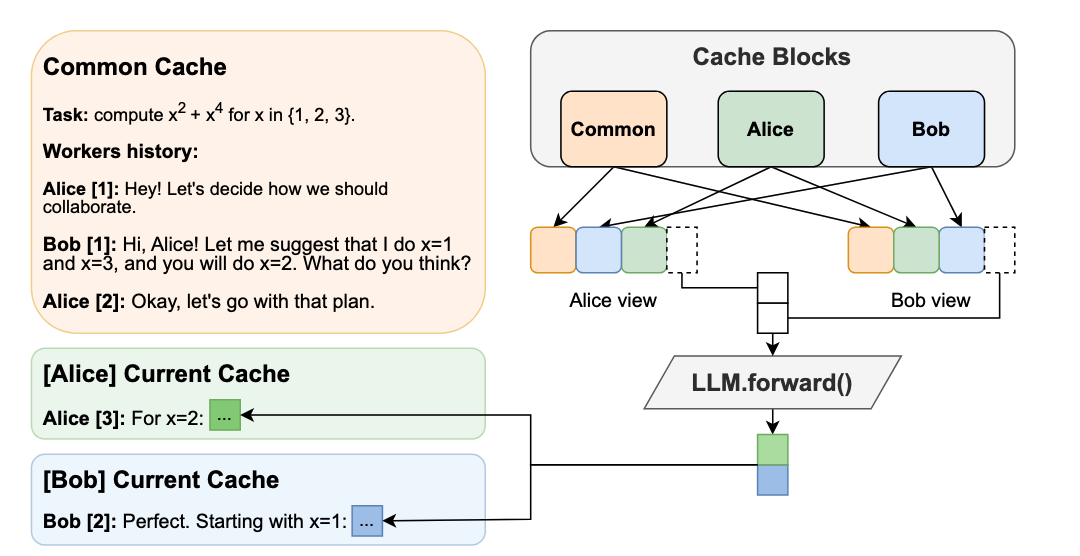
- Parallel Scaling Law for Language Models (https://arxiv.org/pdf/2505.10475). The authors introduce a novel "parallel" scaling method for LLMs (ParScale), distinct from traditional parameter (Dense, MoE) or inference-time (CoT) scaling. The technique processes a single input through 'P' parallel streams, each modified by a unique, learnable prefix vector. These streams are run concurrently on the same base model, and their outputs are intelligently aggregated by a small network. This method yields a quality improvement equivalent to increasing the model size by a factor of log(P), without actually expanding the core parameter count. For example, 8 parallel streams can match the performance of a model three times larger. ParScale is highly efficient for local inference, where memory bandwidth is the main bottleneck. Compared to direct parameter scaling for similar quality, it can require up to 22x less additional RAM and add 6x less latency. The approach can be applied for pretrained models, even with frozen weight, fine-tune only perscale components. The code is available at https://github.com/QwenLM/ParScale.
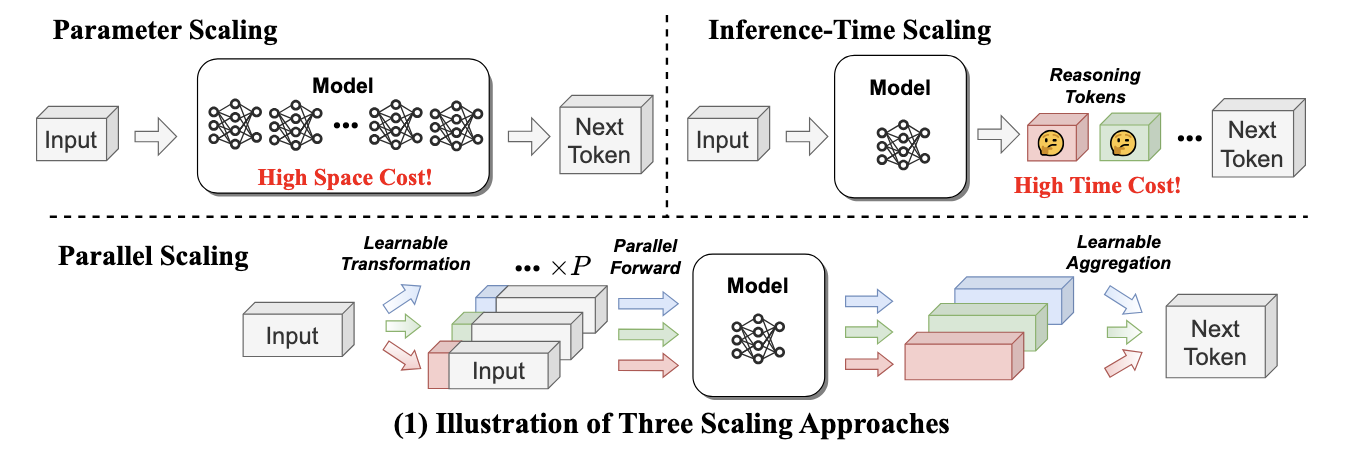
- Packing Input Frame Context in Next-Frame Prediction Models for Video Generation (https://arxiv.org/pdf/2504.12626). FramePack is a framework for next-frame prediction video generators that enables long-duration video synthesis with a constant computational cost (O(1)), regardless of length. It circumvents growing context windows by maintaining a fixed-size token buffer and codes input frames as shown in the figure below. To maintain temporal consistency and mitigate error accumulation, the system employs a bi-directional sampling scheme, alternating between forward and backward prediction passes. This efficiency allows a 13-billion parameter model to generate over 1800 frames (1 minute @ 30 fps) on a GPU with only 6GB of VRAM. The O(1) complexity in memory and latency makes FramePack a practical solution for generating minute-long videos on consumer hardware, with generation speeds of ~1.5 seconds per frame reported on an RTX 4090.The code is available at https://github.com/lllyasviel/FramePack.
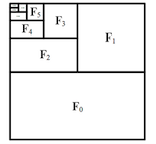
- MoDM: Efficient Serving for Image Generation via Mixture-of-Diffusion Models (https://arxiv.org/pdf/2503.11972). Diffusion-based text-to-image generation models trade latency for quality: small models are fast but generate lower quality images, while large models produce better images but are slow. This paper presents MoDM, a novel caching-based serving system for diffusion models that dynamically balances latency and quality through a mixture of diffusion models.Unlike prior approaches that rely on model-specific internal features, MoDM caches final images, allowing seamless retrieval and reuse across multiple diffusion model families.This design enables adaptive serving by dynamically balancing latency and image quality: using smaller models for cache-hit requests to reduce latency while reserving larger models for cache-miss requests to maintain quality. Small model image quality is preserved using retrieved cached images. MoDM has a global monitor that optimally allocates GPU resources and balances inference workload, ensuring high throughput while meeting Service-Level Objectives (SLOs) under varying request rates. Extensive evaluations show that MoDM significantly reduces an average serving time by 2.5× while retaining image quality, making it a practical solution for scalable and resource-efficient model deployment.
- Fast-dLLM: Training-free Acceleration of Diffusion LLM by Enabling KV Cache and Parallel Decoding (https://arxiv.org/abs/2505.22618). Fast-dLLM is a training-free method to accelerate diffusion-based large language models by introducing a block-wise KV Cache and confidence-aware parallel decoding. The block-wise KV Cache reuses more than 90% of attention activations with bidirectional (prefix and suffix) caching, delivering throughput improvements ranging from 8.1x to 27.6x while keeping accuracy loss under 2%. Confidence-aware parallel decoding selectively generates tokens that exceed a set confidence threshold (like 0.9), achieving up to 13.3x speedup and preserving output coherence thanks to theoretical guarantees. Experimentally, Fast-dLLM achieves up to 27.6× end-to-end speedup on 1024-token sequences (e.g., LLaDA, 8-shot) and keeps accuracy within 2% of the baseline across major reasoning and code benchmarks including GSM8K, MATH, HumanEval, and MBPP.
- SANA-Sprint: One-Step Diffusion with Continuous-Time Consistency Distillation (https://arxiv.org/pdf/2503.09641). SANA-Sprint is a highly efficient text-to-image diffusion model designed for ultra-fast generation. Its core innovation is a hybrid distillation framework that combines continuous-time consistency models (sCM) with latent adversarial diffusion distillation (LADD). This approach drastically reduces inference requirements from over 20 steps to just 1-4. Key performance benchmarks establish a new state-of-the-art. In a single step, SANA-Sprint generates a 1024x1024 image with FID of 7.59. This is achieved with a latency of just 0.1 seconds on an NVIDIA H100 GPU and 0.31 seconds on a consumer RTX 4090. This makes it approximately 10 times faster than its competitor, FLUX-schnell, while also delivering higher image quality.The code is available at https://github.com/NVlabs/Sana.
Software
- FlashRNN: I/O-Aware Optimization of Traditional RNNs on modern hardware (https://arxiv.org/abs/2412.07752). FlashRNN extends traditional RNNs - such as LSTMs and GRUs - by introducing a parallelization scheme where the hidden state is divided into multiple smaller blocks, allowing for parallel computation similar to the head-wise processing in Transformers. The authors develop and open-source custom fused CUDA and Triton kernels that leverage the GPU memory hierarchy efficiently for both forward and backward passes, together with an automatic hardware-aware optimization framework. This approach achieves up to 50x speedup over vanilla PyTorch implementations, making RNNs competitive with Transformer-like models on modern GPUs. The code is available at: https://github.com/NX-AI/flashrnn.
- Nano-vLLM (https://github.com/GeeeekExplorer/nano-vllm). A lightweight vLLM implementation built from scratch.Key Features: (1)🚀 Fast offline inference - Comparable inference speeds to vLLM (2)📖 Readable codebase - Clean implementation in ~ 1,200 lines of Python code (3)⚡ Optimization Suite - Prefix caching, Tensor Parallelism, Torch compilation, CUDA graph, etc.
- NeMo-Inspector: A Visualization Tool for LLM Generation Analysis (https://arxiv.org/pdf/2505.00903). The authors introduce NeMo-Inspector, an open-source tool designed to simplify the analysis of synthetic datasets with integrated inference capabilities.
- FlashInfer: Efficient and Customizable Attention Engine for LLM Inference Serving (https://arxiv.org/pdf/2501.01005). The authors present FlashInfer: a customizable and efficient attention engine for LLM serving. FlashInfer tackles KV-cache storage heterogeneityusing block-sparse format and composable formats to optimize memory access and reduce redundancy, supports JIT compilation and load-balanced scheduling algorithm adjusts to dynamism of user requests while maintaining compatibility with CUDAGraph which requires static configuration. FlashInfer achieve29-69% inter-token-latency reduction compared to Triton, 28-30% latency reduction for long-context inference, and 13-17% speedup for LLM serving with parallel generation.The code is available at https://github.com/flashinfer-ai/flashinfer.
OpenVINO.GenAI Delivers C API for Seamless Language Interop with Practical Examples in .NET
Authors: Tong Qiu, Xiake Sun
Starting with OpenVINO.GenAI 2025.1, the C API has been introduced, primarily to enhance interoperability with other programming languages, enabling developers to more effectively utilize OpenVINO-based generative AI across diverse coding environments.
Compared to C++, C's ABI is more stable, often serving as an interface layer or bridge language for cross-language interoperability and integration. This allows developers to leverage the performance benefits of C++ in the backend while using other high-level languages for easier implementation and integration.
As a milestone, we have currently delivered only the LLMPipeline and its associated C API interface. If you have other requirements or encounter any issues during usage, please submit an issue to OpenVINO.GenAI
Currently, we have implemented a Go application Ollama using the C API (Please refer to https://blog.openvino.ai/blog-posts/ollama-integrated-with-openvino-accelerating-deepseek-inference), which includes more comprehensive features such as performance benchmarking for developers reference.
Now, let's dive into the design logic of the C API, using a .NET C# example as a case study, based on the Windows platform with .NET 8.0.
Live Demo
Before we dive into the details, let's take a look at the final C# version of the ChatSample, which supports multi-turn conversations. Below is a live demo

How to Build a Chat Sample by C#
P/Invoke: Wrapping Unmanaged Code in .NET
First, the official GenAI C API can be found in this folder https://github.com/openvinotoolkit/openvino.genai/tree/master/src/c/include/openvino/genai/c . We also provide several pure C samples https://github.com/openvinotoolkit/openvino.genai/tree/master/samples/c/text_generation . Now, we will build our own C# Chat Sample based on the chat_sample_c. This sample can facilitate multi-turn conversations with the LLM.
C# can access structures, functions and callbacks in the unmanaged library openvino_genai_c.dll through P/Invoke. This example demonstrates how to invoke unmanaged functions from managed code.
public static class NativeMethods
{
DllImport("openvino_genai_c.dll", CallingConvention = CallingConvention.Cdecl)]
public static extern ov_status_e ov_genai_llm_pipeline_create(
[MarshalAs(UnmanagedType.LPStr)] string models_path,
[MarshalAs(UnmanagedType.LPStr)] string device,
out IntPtr pipe);
[DllImport("openvino_genai_c.dll", CallingConvention = CallingConvention.Cdecl)]
public static extern void ov_genai_llm_pipeline_free(IntPtr pipeline);
//Other methods
The dynamic library openvino_genai_c.dll is imported, which relies on openvino_genai.dll. CallingConvention = CallingConvention.Cdecl here corresponds to the default calling convention _cdecl in C, which defines the argument-passing order, stack-maintenance responsibility, and name-decoration convention. For more details, refer to Argument Passing and Naming Conventions.
Additionally, the return value ov_status_e reuses an enum type from openvino_c.dll to indicate the execution status of the function. We need to implement a corresponding enum type in C#, such as
public enum ov_status_e
{
OK = 0,
GENERAL_ERROR = -1,
NOT_IMPLEMENTED = -2,
//...
}
Next, we will implement our C# LLMPipeline, which inherits the IDisposable interface. This means that its instances require cleanup after use to release the unmanaged resources they occupy. In practice, object allocation and deallocation for native pointers are handled through the C interface provided by OpenVINO.GenAI. The OpenVINO.GenAI library takes full responsibility for memory management, which ensures memory safety and eliminates the risk of manual memory errors.
public class LlmPipeline : IDisposable
{
private IntPtr _nativePtr;
public LlmPipeline(string modelPath, string device)
{
var status = NativeMethods.ov_genai_llm_pipeline_create(modelPath, device, out _nativePtr);
if (_nativePtr == IntPtr.Zero || status != ov_status_e.OK)
{
Console.WriteLine($"Error: {status} when creating LLM pipeline.");
throw new Exception("Failed to create LLM pipeline.");
}
Console.WriteLine("LLM pipeline created successfully!");
}
public void Dispose()
{
if (_nativePtr != IntPtr.Zero)
{
NativeMethods.ov_genai_llm_pipeline_free(_nativePtr);
_nativePtr = IntPtr.Zero;
}
GC.SuppressFinalize(this);
}
// Other Methods
}
Callback Implementation
Next, let's implement the most complex method of the LLMPipeline, the GenerateStream method. This method encapsulates the LLM inference process. Let's take a look at the original C code. The result can be retrieved either via ov_genai_decoded_results or streamer_callback. ov_genai_decoded_results provides the inference result all at once, while streamer_callback allows for streaming inference results. ov_genai_decoded_results or streamer_callback must be non-NULL; neither can be NULL at the same time. For more information please refer to the comments https://github.com/openvinotoolkit/openvino.genai/blob/master/src/c/include/openvino/genai/c/llm_pipeline.h
// code snippets from //https://github.com/openvinotoolkit/openvino.genai/blob/master/src/c/include/openvino/genai/c/llm_// pipeline.h
typedef enum {
OV_GENAI_STREAMMING_STATUS_RUNNING = 0, // Continue to run inference
OV_GENAI_STREAMMING_STATUS_STOP =
1, // Stop generation, keep history as is, KV cache includes last request and generated tokens
OV_GENAI_STREAMMING_STATUS_CANCEL = 2 // Stop generate, drop last prompt and all generated tokens from history, KV
// cache includes history but last step
} ov_genai_streamming_status_e;
// ...
typedef struct {
ov_genai_streamming_status_e(
OPENVINO_C_API_CALLBACK* callback_func)(const char* str, void* args); //!< Pointer to the callback function
void* args; //!< Pointer to the arguments passed to the callback function
} streamer_callback;
// ...
OPENVINO_GENAI_C_EXPORTS ov_status_e ov_genai_llm_pipeline_generate(ov_genai_llm_pipeline* pipe,
const char* inputs,
const ov_genai_generation_config* config,
const streamer_callback* streamer,
ov_genai_decoded_results** results);
The streamer_callback structure includes not only the callback function itself, but also an additional void* args for enhanced flexibility. This design allows developers to pass custom context or state information to the callback.
For example, in C++ it's common to pass a this pointer through args, enabling the callback function to access class members or methods when invoked.
// args is a this pointer
void callback_func(const char* str, void* args) {
MyClass* self = static_cast<MyClass*>(args);
self->DoSomething();
}
This C# code defines a class StreamerCallback that helps connect a C callback function with a C# method. It wraps a C function pointer MyCallbackDelegate and a void* args into a struct.
- ToNativePTR method constructs the streamer_callback structure, allocates a block of memory, and copies the structure's data into it, allowing it to be passed to a native C function.
- GCHandle is used to safely pin the C# object so that it can be passed as a native pointer to unmanaged C code.
- CallbackWrapper method is the actual function that C code will call.
[UnmanagedFunctionPointer(CallingConvention.Cdecl)]
public delegate ov_genai_streamming_status_e MyCallbackDelegate(IntPtr str, IntPtr args);
[StructLayout(LayoutKind.Sequential)]
public struct streamer_callback
{
public MyCallbackDelegate callback_func;
public IntPtr args;
}
public class StreamerCallback : IDisposable
{
public Action<string> OnStream;
public MyCallbackDelegate Delegate;
private GCHandle _selfHandle;
public StreamerCallback(Action<string> onStream)
{
OnStream = onStream;
Delegate = new MyCallbackDelegate(CallbackWrapper);
_selfHandle = GCHandle.Alloc(this);
}
public IntPtr ToNativePtr()
{
var native = new streamer_callback
{
callback_func = Delegate,
args = GCHandle.ToIntPtr(_selfHandle)
};
IntPtr ptr = Marshal.AllocHGlobal(Marshal.SizeOf<streamer_callback>());
Marshal.StructureToPtr(native, ptr, false);
return ptr;
}
public void Dispose()
{
if (_selfHandle.IsAllocated)
_selfHandle.Free();
}
private ov_genai_streamming_status_e CallbackWrapper(IntPtr str, IntPtr args)
{
string content = Marshal.PtrToStringAnsi(str) ?? string.Empty;
if (args != IntPtr.Zero)
{
var handle = GCHandle.FromIntPtr(args);
if (handle.Target is StreamerCallback self)
{
self.OnStream?.Invoke(content);
}
}
return ov_genai_streamming_status_e.OV_GENAI_STREAMMING_STATUS_RUNNING;
}
}
Then We implemented the GenerateStream method in class LLMPipeline.
public void GenerateStream(string input, GenerationConfig config, StreamerCallback? callback = null)
{
IntPtr configPtr = config.GetNativePointer();
IntPtr decodedPtr;// placeholder
IntPtr streamerPtr = IntPtr.Zero;
if (callback != null)
{
streamerPtr = callback.ToNativePtr();
}
var status = NativeMethods.ov_genai_llm_pipeline_generate(
_nativePtr,
input,
configPtr,
streamerPtr,
out decodedPtr
);
if (streamerPtr != IntPtr.Zero)
Marshal.FreeHGlobal(streamerPtr);
callback?.Dispose();
if (status != ov_status_e.OK)
{
Console.WriteLine($"Error: {status} during generation.");
throw new Exception("Failed to generate results.");
}
return;
}
We use the following code to invoke our callback and GenerateStream.
pipeline.StartChat(); // Start chat with keeping history in kv cache.
Console.WriteLine("question:");
while (true)
{
string? input = Console.ReadLine();
if (string.IsNullOrWhiteSpace(input)) break;
using var streamerCallback = new StreamerCallback((string chunk) =>
{
Console.Write(chunk);
});
pipeline.GenerateStream(input, generationConfig, streamerCallback);
input = null;
Console.WriteLine("\n----------\nquestion:");
}
pipeline.FinishChat(); // Finish chat and clear history in kv cache.
About Deployment
We can directly download the OpenVINO official release of the LLM's IR from Hugging Face using this link.
git clone https://huggingface.co/OpenVINO/Phi-3.5-mini-instruct-int8-ov
The OpenVINO.GenAI 2025.1 package can be downloaded via this link.
The C# project directly depends on openvino_genai_c.dll, which in turn has transitive dependencies on other toolkit-related DLLs, including Intel TBB libraries.
To ensure proper runtime behavior, all the DLLs delivered with OpenVINO.GenAI — including openvino_genai_c.dll and its dependencies — are bundled and treated as part of the C# project’s runtime dependencies.
We use the following cmd commands to download the genai package and copy all the required dependent DLLs to the directory containing the *.csproj file.
curl -O https://storage.openvinotoolkit.org/repositories/openvino_genai/packages/2025.1/windows/openvino_genai_windows_2025.1.0.0_x86_64.zip
tar -xzvf openvino_genai_windows_2025.1.0.0_x86_64.zip
xcopy /y openvino_genai_windows_2025.1.0.0_x86_64\runtime\bin\intel64\Release\*.dll "C:\path\to\ChatSample\"
xcopy /y openvino_genai_windows_2025.1.0.0_x86_64\runtime\3rdparty\tbb\bin\*.dll "C:\path\to\ChatSample\"
Full Implementation
Please refer to https://github.com/apinge/openvino_ai_practice/tree/main/ov_genai_interop/ov_genai_interop_net, to access the full implementation.
Q1'25: Technology Update – Low Precision and Model Optimization
Authors
Alexander Kozlov, Nikolay Lyalyushkin, Nikita Savelyev, Souvikk Kundu, Andrey Anufriev, Pablo Munoz, Alexander Suslov, Liubov Talamanova, Daniil Lyakhov, Yury Gorbachev, Nilesh Jain, Maxim Proshin, Evangelos Georganas
Summary
This quarter we noticed a significant effort and progress on optimizing LLMs for long-context tasks. The current trend is that each and every LLM is published with the extended (usually interpolated) context which is usually 128K and above. The idea is to naturally process large amount of data within the model instead of preprocess it the way RAG systems do it. It inevitably increases computational complexity specifically of ScaledDotProductAttention operation which gets dominant on long contexts. Thus, many works devoted to the optimization of rather prefill with special computation patterns (A-shape, Tri-shape, XAttention) or using Sparse Attention at the decoding stage.
Highlights
- ParetoQ: Scaling Laws in Extremely Low-bit LLM Quantization by Meta (https://arxiv.org/pdf/2502.02631). The paper presents a unified framework that facilitates comparisons across 1-bit, 1.58-bit, 2-bit, 3-bit, and 4-bit quantization settings. The findings reveal a notable learning transition between 2 and 3 bits: For 3-bits and above, the fine-tuned models stay close to their original pre-trained distributions, whereas for learning 2-bit networks or below, the representations change drastically. By optimizing training schemes and refining quantization functions, the ternary 600M-parameter model even outperforms the previous SoTA ternary 3B-parameter model in accuracy, using only one-fifth of the parameters.
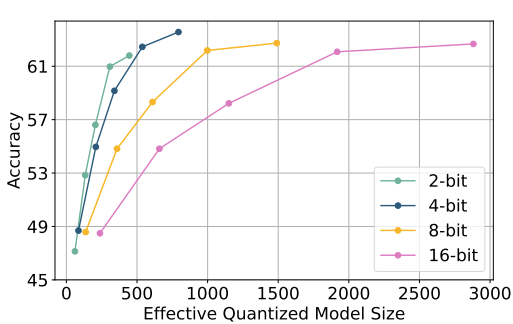
- QuEST: Stable Training of LLMs with 1-Bit Weights and Activations by ISTA and Red Hat AI (https://arxiv.org/pdf/2502.05003). The paper introduces quantization method that allows stable training with 1-bit weights and activations. It achieves this by improving two key aspects of QAT methods: (1) accurate and fast quantization of the (continuous) distributions of weights and activations via Hadamard normalization and MSE-optimal fitting; (2) a new trust gradient estimator based on the idea of explicitly minimizing the error between the noisy gradient computed over quantized states and the “true” (but unknown) full-precision gradient. Experiments on Llama-type architectures show that the method induces stable scaling laws across the entire range of hardware-supported precisions, and can be extended to sparse representations. The code is available at https://github.com/IST-DASLab/QuEST.

- Native Sparse Attention: Hardware-Aligned and Natively Trainable Sparse Attention by Deepseek-AI, Peking University, University of Washington (https://arxiv.org/pdf/2502.11089). The paper presents a method with hardware-aligned optimizations to achieve efficient long-context modeling. It employs a dynamic hierarchical sparse strategy, combining coarse-grained token compression with fine-grained token selection to preserve both global context awareness and local precision. The approach advances sparse attention design with two key features: (1) Authors achieve substantial speedups through arithmetic intensity-balanced algorithm design, with implementation optimizations for modern hardware. (2) They enable end-to-end training, reducing pretraining computation without sacrificing model performance. Experiments show the model pretrained with the proposed method maintains or exceeds Full Attention models across general benchmarks, long-context tasks, and instruction-based reasoning. It achieves substantial speedups over Full Attention on 64k-length sequences across decoding, forward propagation, and backward propagation. Non-official implementations are available on GitHub.

- LSERVE: EFFICIENT LONG-SEQUENCE LLM SERVING WITH UNIFIED SPARSE ATTENTION by MIT, SJTU, Nvidia (https://arxiv.org/pdf/2502.14866). The paper introduces a system that accelerates long-sequence LLM serving via hybrid sparse attention. This method unifies different hardware-friendly, structured sparsity patterns for both prefilling and decoding attention into a single framework, where computations on less important tokens are skipped block-wise. It demonstrates the compatibility of static and dynamic sparsity in long-context LLM attention. Authors convert half of the attention heads to nearly free streaming heads in both the prefilling and decoding stages. Additionally, we they that only a constant number of KV pages is required to preserve long-context capabilities, irrespective of context length. They then design a hierarchical KV page selection policy that dynamically prunes KV pages based on query-centric similarity. The method accelerates LLM prefilling by up to 2.9x and decoding by 1.3-2.1x over vLLM, maintaining long-context accuracy. Code is released at https://github.com/mit-han-lab/omniserve.

- XAttention: Block Sparse Attention with Antidiagonal Scoring by Tsinghua University, MIT, SJTU, and NVIDIA (https://arxiv.org/pdf/2503.16428). The paper introduces XAttention method that significantly accelerates long-context inference in Transformers models using sparse attention. XAttention’s key innovation is the insight that the sum of antidiagonal values (i.e., from the lower-left to upper-right) in the attention matrix provides a powerful proxy for block importance. This allows for precise identification and pruning of non-essential blocks, resulting in high sparsity and dramatically accelerated inference. On RULER and LongBench for language, VideoMME for video understanding, and VBench for video generation—XAttention achieves accuracy comparable to full attention while delivering substantial computational gains. It shows up to 13.5x acceleration in attention computation. The code is available at https://github.com/mit-han-lab/x-attention.
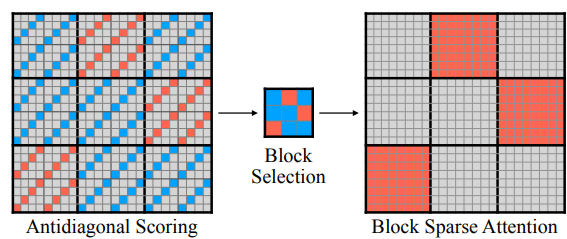
Papers with notable results
Quantization
- Optimizing Large Language Model Training Using FP4 Quantization by Microsoft and University of Science and Technology of China (https://arxiv.org/pdf/2501.17116). The work introduces the FP4 training framework for LLMs, addressing quantization challenges with two key ideas: a differentiable quantization estimator for precise weight updates and an outlier clamping and compensation strategy to prevent activation collapse. To ensure stability, the framework integrates a mixed-precision training scheme and vector-wise quantization. Experimental results demonstrate that our FP4 framework achieves accuracy comparable to BF16 and FP8, with minimal degradation, scaling effectively to 13B-parameter LLMs trained on up to 100B.
- MQuant: Unleashing the Inference Potential of Multimodal Large Language Models via Full Static Quantization by Houmo AI, Southeast University, and Xi’an Jiaotong University (https://arxiv.org/pdf/2502.00425). The work focuses on the problems of VLM quantization with a coarse scale granularity. It proposes several techniques to tackle the quantization problems, namely: Modality-Specific Static Quantization (MSQ), assigning distinct static scales for visual vs. textual tokens; Attention-Invariant Flexible Switching (AIFS), reordering tokens to preserve casual attention while eliminating expensive token-wise scale computations; Rotation Magnitude Suppression (RMS), mitigating weight outliers arising from online Hadamard rotations. On five mainstream VLMs (including Qwen-VL, MiniCPM-V, CogVLM2), the method achieves near-floating-point accuracy under W4A8 setting. The code is planned to be published.
- An Empirical Study of LLaMA3 Quantization: From LLMs to MLLMs by The University of Hong Kong, Beihang University, and ETH Zurich (https://arxiv.org/pdf/2404.14047). Authors assessed the performance of the LLaMA3-based LLaVA-Next-8B model under 2-4 ultra-low bits with post-training quantization methods. Experimental results indicate that LLaMA3 still suffers from non-negligible degradation in linguistic and visual contexts, particularly under ultra-low bit widths. This highlights the significant performance gap at low bit-width that needs to be addressed in future developments. The code is available at: https://github.com/Macaronlin/LLaMA3-Quantization.
- Nanoscaling Floating-Point (NxFP): NanoMantissa, Adaptive Microexponents, and Code Recycling for Direct-Cast Compression of Large Language Models by Harvard University (https://arxiv.org/pdf/2412.19821). This paper profiles modern LLMs and identifies three main challenges of low-bit Microscaling format, i.e., inaccurate tracking of outliers, vacant quantization levels, nd wasted binary code. In response, Nanoscaling (NxFP) proposes three techniques, i.e., NanoMantissa, Adaptive Microexponent, and Code Recycling to enable better accuracy and smaller memory footprint than state-of-the-art MxFP. Experimental results on direct-cast inference across various modern LLMs demonstrate that the proposed methods outperform MxFP by up to 0.64 in perplexity and by up to 30% in accuracy on MMLU benchmarks.
- RoSTE: An Efficient Quantization-Aware Supervised Fine-Tuning Approach for Large Language Models by University of Minnesota and The Chinese University of Hong Kong (https://arxiv.org/pdf/2502.09003). The paper introduces a fine-tuning based method that directly optimizes quantized weights and rotation matrices within a single model architecture. It proposes a bilevel optimization formulation, where upper level subproblem optimizes weight matrices, while lower level subproblem employs a surrogate loss to guide the selection of rotation matrix. Authors designed an algorithm which alternates between (i) a QAT subroutine incorporating a rotation-enabled straightthrough-estimator (STE) update, and (ii) a low complexity heuristic for selecting rotation matrices based on the random Walsh-Hadamard matrix. They provide a theoretical analysis of the benefits of rotation-enabled quantization in QA-SFT by examining the prediction error resulted from the QAT stage of RoSTE. This analysis directly motivates the use of quantization error based surrogate loss and justifies the adoption.
- NESTQUANT: NESTED LATTICE QUANTIZATION FOR MATRIX PRODUCTS AND LLMS by MIT and Hebrew University of Jerusalem (https://arxiv.org/pdf/2502.09720). The paper proposes a PTQ scheme for weights and activations that is based on self-similar nested lattices. Recent work has mathematically shown such quantizers to be information-theoretically optimal for low-precision matrix multiplication. We implement a practical low-complexity version based on Gosset lattice, making it a drop-in quantizer for any matrix multiplication step (e.g., in self-attention, MLP etc). For example, the method quantizes weights, KV-cache, and activations of Llama-3-8B to 4 bits, achieving perplexity of 6.6 on wikitext2.
- ViM-VQ: Efficient Post-Training Vector Quantization for Visual Mamba by Zhejiang University and vivo Mobile (https://arxiv.org/pdf/2503.09509). A practical study of vector quantization method for Visual Mamba networks (ViMs). Authors identify several key challenges: 1) The weights of Mamba-based blocks in ViMs contain numerous outliers, significantly amplifying quantization errors. 2) When applied to ViMs, the latest VQ methods suffer from excessive memory consumption, lengthy calibration procedures, and suboptimal performance in the search for optimal codewords. They propose a post-training vector quantization method tailored for ViMs. It consists of two components: 1) a fast convex combination optimization algorithm that updates both the convex combinations and the convex hulls to search for optimal codewords, and 2) an incremental vector quantization strategy that incrementally confirms optimal codewords to mitigate truncation errors. The results demonstrate that the method achieves stateof-the-art performance in low-bit quantization across various visual tasks.
- SSVQ: Unleashing the Potential of Vector Quantization with Sign-Splitting by Zhejiang University and vivo Mobile (https://arxiv.org/pdf/2503.08668). The paper proposes the vector quantization approach which decouples the sign bit of weights from the codebook. It involves extracting the sign bits of uncompressed weights and performing clustering and compression on all-positive weights. Authors also introduce latent variables for the sign bit and jointly optimize both the signs and the codebook. Additionally, they implement a progressive freezing strategy for the learnable sign to ensure training stability. Experiments on modern models and tasks demonstrate that the method achieves a good compression-accuracy trade-off compared to conventional VQ. Authors also validate the algorithm on a hardware accelerator, showing that SSVQ achieves a 3× speedup over the 8-bit compressed model by reducing memory access.
- MergeQuant: Accurate 4-bit Static Quantization of Large Language Models by Channel-wise Calibration (https://arxiv.org/pdf/2503.07654). The paper introduces per-channel static quantization method. It integrates the per-channel quantization steps with the corresponding scalings and linear mappings through a Quantization Step Migration method, eliminating the quantization overheads before and after matrix multiplication. Authors also propose dimensional reconstruction and adaptive clipping to address the nonuniformity of quantization scale factors and redistribute the channel variations to the subsequent modules to balance the parameter distribution under QSM. They evaluate method on Llama 2 and Llama 3 models in W4A4 setting.
- QuantCache: Adaptive Importance-Guided Quantization with Hierarchical Latent and Layer Caching for Video Generation by Shanghai Jiao Tong University, MGTV, Shanhai Academy (https://arxiv.org/pdf/2503.06545). Authors propose a training-free inference acceleration framework that jointly optimizes hierarchical latent caching, adaptive importance-guided quantization, and structural redundancy-aware pruning. It achieves an end-to-end latency speedup of 6.72x on OpenSora with minimal loss in generation quality. experiments across multiple video generation benchmarks demonstrate the effectiveness of our method for DiT inference. The code and models will be available at https://github.com/JunyiWuCode/QuantCache.
- Matryoshka Quantization by Google DeepMind (https://arxiv.org/pdf/2502.06786). Practitioners are often forced to maintain multiple models with different quantization levels or serve a single model that best satisfies the quality-latency trade-off. On the other hand, integer data types, such as int8, inherently possess a nested (Matryoshka) structure where smaller bit-width integers, like int4 or int2, are nested within the most significant bits. In this paper, the authors propose Matryoshka Quantization (MatQuant), a multi-scale quantization technique that alleviates the aforementioned challenge. It allows us to train and maintain a single quantized model but serve it with the precision demanded by the deployment. Furthermore, leveraging MatQuant’s co-training and co-distillation regularization, int2 precision models extracted by MatQuant outperform standard int2 quantization by up to to 4% and 7% with OmniQuant and QAT as base algorithms respectively. Finally, authors demonstrate that by using an extra bit to represent outliers, a model with an effective precision of 2.05-bit gives an additional 6% improvement with OmniQuant as the base algorithm.
Pruning/Sparsity
- Mamba-Shedder: Post-Transformer Compression for Efficient Selective Structured State Space Models by Intel Labs (https://arxiv.org/pdf/2501.17088v1). This paper explores the compression of SSM-based models, particularly Mamba and its hybrids. The authors discuss the sensitivity of these models to the removal of selected components at different granularities to reduce the model size and computational overhead, thus improving their efficiency while maintaining accuracy. The proposed solutions, collectively referred to as Mamba-Shedder, achieve a speedup of up to 1.4x during inference, demonstrating that model efficiency can be improved by eliminating several redundancies with minimal impact on the overall model performance. The code is available at https://github.com/IntelLabs/Hardware-Aware-Automated-Machine-Learning.
- DeepSeekAI, The Sparsity Revolution That Shook the AI Market: https://www.linkedin.com/pulse/deepseek-ai-sparsity-revolution-shook-market-jabar-riaz-hwvbf. The blogpost discusses two types of sparsity to train efficient and competitive LLM models, namely data sparsity and model sparsity.
Other
- TPU Scaling Book from Google - a series of blog posts on how to optimize LLMs for Google TPUv5: https://jax-ml.github.io/scaling-book/applied-inference.
- The Ultra-Scale Playbook: Training LLMs on GPU Clusters https://huggingface.co/spaces/nanotron/ultrascale-playbook. A tutorial from HuggingFace on the basics of multi-GPU training and how to scale it.
- Qwen2.5-1M Technical Report by Alibaba (https://qianwen-res.oss-cn-beijing.aliyuncs.com/Qwen2.5-1M/Qwen2_5_1M_Technical_Report.pdf). Authors introduce Qwen2.5-1M, a series of models that extend the context length to 1 million tokens. Compared to the previous 128K version, the Qwen2.5-1M series has significantly enhanced long-context capabilities through long-context pretraining and post-training. To reduce inference costs, authors implement a sparse attention method along with chunked prefill optimization for deployment scenarios and a sparsity refinement method to improve precision. Additionally, they detail optimizations in the inference engine, including kernel optimization, pipeline parallelism, and scheduling optimization, which significantly enhance overall inference performance. Qwen2.5-1M models achieve a remarkable 3x to 7x prefill speedup in scenarios with 1 million tokens of context.
- WaferLLM: A Wafer-Scale LLM Inference System by University of Edinburgh and Microsoft (https://arxiv.org/pdf/2502.04563). The paper introduces LLM inference system that is guided by a device model that captures the unique hardware characteristics of wafer-scale architectures. It proposes MeshGEMM and MeshGEMV, the GEMM and GEMV implementations designed to scale effectively on wafer-scale accelerator. Authors focus on four principles when designing the implementation: Massive Parallel cores, Highly non-uniform memory access Latency, Constrained local Memory, and Limited hardware-assisted Routing. Evaluations show that the method achieves 200× better wafer-scale accelerator utilization than state-of-the-art systems. On a commodity wafer-scale accelerator, it delivers 606× faster and 22× more energy-efficient GEMV compared to an advanced GPU. One of the limitations of the method is a limited model size due to a need to replicate memory over the computational units to increase the latency.
- EmbBERT-Q: Breaking Memory Barriers in Embedded NLP by Politecnico di Milano (https://arxiv.org/pdf/2502.10001). The paper proposes a new LM model specifically designed for tiny devices, combining efficiency and effectiveness. Authors analytically evaluate the memory usage and computational complexity of the model and its components, providing a tool to evaluate the weights and activations of memory trade-offs required to operate within tiny device constraints. They also release all code, scripts, and model checkpoints at https://github.com/RiccardoBravin/tiny-LLM.
- M2R2: MIXTURE OF MULTI-RATE RESIDUALS FOR EFFICIENT TRANSFORMER INFERENCE by Apple (https://arxiv.org/pdf/2502.02040). The paper introduce Mixture of Multi-rate Residuals, a framework that dynamically modulates the velocity of residual transformations to optimize early residual alignment. This modification improves inference efficiency by better aligning intermediate representations at earlier stages. Authors show the efficacy of the technique in diverse optimization setups such as dynamic computing, speculative decoding, and MoE Ahead-of-Time. In self-speculative decoding setups, M2R2 achieves up to 2.8X speedups on MT-Bench under lossless conditions. In Mixture-of-Experts architectures, they enhance decoding speed by coupling early residual alignment with ahead-of-time expert loading into high-bandwidth memory. This enables concurrent memory access and computation, reducing the latency bottlenecks inherent in expert switching during decoding. Empirical results show that the method delivers a speedup of 2.9X in MoE architectures.
- Extending Language Model Context Up to 3 Million Tokens on a Single GPU by KAIST and DeepAuto.ai (https://arxiv.org/pdf/2502.08910). To enable efficient and practical long-context utilization, authors introduce an LLM inference framework that accelerates processing by dynamically eliminating irrelevant context tokens through a modular hierarchical token pruning algorithm. The method also allows generalization to longer sequences by selectively applying various RoPE adjustment methods according to the internal attention patterns within LLMs. They also offload the key-value cache to host memory during inference, significantly reducing GPU memory pressure. As a result, the method enables the processing of up to 3 million tokens on a single L40s 48GB GPU without any permanent loss of context information. The framework achieves an 18.95x.
- KernelBench: Can LLMs Write Efficient GPU Kernels? by Stanford University and Princeton University (https://arxiv.org/pdf/2502.10517). The paper introduces KernelBench, an open-source framework for evaluating LMs’ ability to write fast and correct kernels on a suite of 250 carefully selected PyTorch ML workloads. KernelBench represents a real-world engineering environment and making progress on the introduced benchmark directly translates to faster practical kernels. Auhors introduce a new evaluation metric fastp, which measures the percentage of generated kernels that are functionally correct and offer a speedup greater than an adjustable threshold p over baseline. Experiments across various models and test-time methods show that frontier reasoning models perform the best out of the box but still fall short overall, matching the PyTorch baseline in less than 20% of the cases.
- Investigating the Impact of Quantization Methods on the Safety and Reliability of Large Language Models by Skolkovo Institute, Artificial Intelligence Research Institute, HSE University (https://arxiv.org/pdf/2502.15799). Authors introduce OpenSafetyMini, a openended safety dataset designed to better distinguish between models. They evaluate 4 state-ofthe-art quantization techniques across LLaMA and Mistral models using 4 benchmarks, including human evaluations. Findings reveal that the optimal quantization method varies for 4-bit precision, while vector quantization techniques deliver the best safety and trustworthiness performance at 2-bit precision, providing foundation for future research. The dataset and reproduces available at: https://github.com/On-Point-RND/OpenSafetyMini-Investigating-the-Impact-of-Quantization-Methods-on-the-Safety-and-Reliability-of-LLM.
- MOBA: MIXTURE OF BLOCK ATTENTION FOR LONG-CONTEXT LLMS by Moonshot AI, Tsinghua University, and Zhejiang University (https://arxiv.org/pdf/2502.13189v1). In this work, authors propose a solution that adheres to the “less structure” principle, allowing the model to determine where to attend autonomously, rather than introducing predefined biases. They introduce Mixture of Block Attention (MoBA), an approach that applies the principles of Mixture of Experts (MoE) to the attention mechanism. It is based on block partitioning and routing strategy within Multi-Head Self-Attention. The code is available at https://github.com/MoonshotAI/MoBA.
- JUDGE DECODING: FASTER SPECULATIVE SAMPLING REQUIRES GOING BEYOND MODEL ALIGNMENT by Meta GenAI and ETH Zurich (https://openreview.net/pdf?id=mtSSFiqW6y). The paper demonstrates through a series of experiments how the decision mechanism in speculative decoding rejects many high-quality tokens, identifying a key limitation of the technique. Authors adapt verification using ideas from LLM-as-a-judge, eliciting the same versatile rating capability in the target by adding a simple linear layer that can be trained in under 1.5 hours. Using a Llama 8B/70B-Judge, the proposed approach obtains speedups of 9x over standard decoding, achieving an unprecedented 129 tokens/s, while maintaining the quality of Llama-405B on a range of benchmarks.
Software
- FlashMLA by Deepseek: https://github.com/deepseek-ai/FlashMLA. FlashMLA is an efficient MLA decoding kernel for Hopper GPUs, optimized for variable-length sequences serving.
- DeepSeek releases DeepGEMM is a library designed for clean and efficient FP8 General Matrix Multiplications (GEMMs) with fine-grained scaling: https://github.com/deepseek-ai/DeepGEMM.
- SVDQuant Meets NVFP4: 4× Smaller and 3× Faster FLUX with 16-bit Quality on NVIDIA Blackwell GPUs: https://hanlab.mit.edu/blog/svdquant-nvfp4.
- M3 Ultra Runs DeepSeek R1 With 671 Billion Parameters Using 448GB Of Unified Memory, Delivering High Bandwidth Performance At Under 200W Power Consumption, With No Need For A Multi-GPU Setup: https://wccftech.com/m3-ultra-chip-handles-deepseek-r1-model-with-671-billion-parameters/.
- NVIDIA TensorRT Model Optimizer: https://github.com/NVIDIA/TensorRT-Model-Optimizer. A Library to Quantize and Compress Deep Learning Models for Optimized Inference on GPUs.
DeepSeek Janus-Pro Model Enabling with OpenVINO
1. Introduction
Janus is a unified multimodal understanding and generation model developed by DeepSeek. Janus proposed decoupling visual encoding to alleviate the conflict between multimodal understanding and generation tasks. Janus-Pro further scales up the Janus model to larger model size (deepseek-ai/Janus-Pro-1B & deepseek-ai/Janus-Pro-7B) with optimized training strategy and training data, achieving significant advancements in both multimodal understanding and text-to-image tasks.
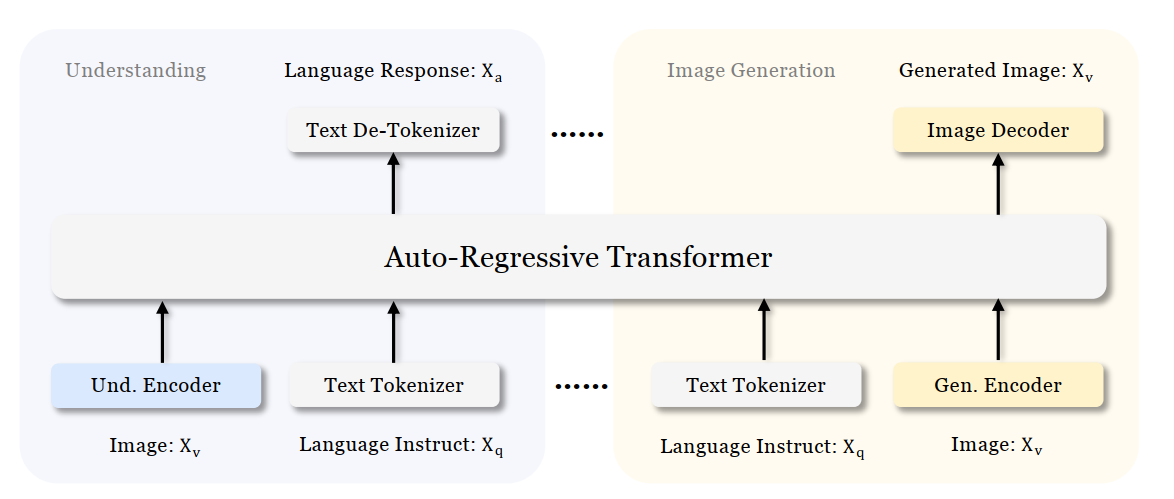
Figure 1 shows the architecture of Janus-Pro, which decouples visual encoding for multimodal understanding and visual generation. “Und. Encoder” and “Gen. Encoder” are abbreviations for “Understanding Encoder” and “Generation Encoder”. For the multimodal understanding task, SigLIP vision encoder used to extract high-dimensional semantic features from the image, while for the vision generation task, VQ tokenizer used to map images to discrete IDs. Both the understanding adaptor and the generation adaptor are two-layer MLPs to map the embeddings to the input space of LLM.
In this blog, we will introduce how to deploy Janus-Pro model with OpenVINOTM runtime on the intel platform.
2. Janus-Pro Pytorch Model to OpenVINOTM Model Conversion
2.1. Setup Python Environment
2.2 Download Janus Pytorch model (Optional)
2.3. Convert Pytorch Model to OpenVINOTM INT4 Model
The converted OpenVINO will be saved in Janus-Pro-1B-OV directory for deployment.
3. Janus-Pro Inference with OpenVINOTM Demo
In this section, we provide several examples to show Janus-Pro for multimodal understanding and vision generation tasks.
3.1. Multimodal Understanding Task – Image Caption with OpenVINOTM
Prompt: Describe image in details
Input image:
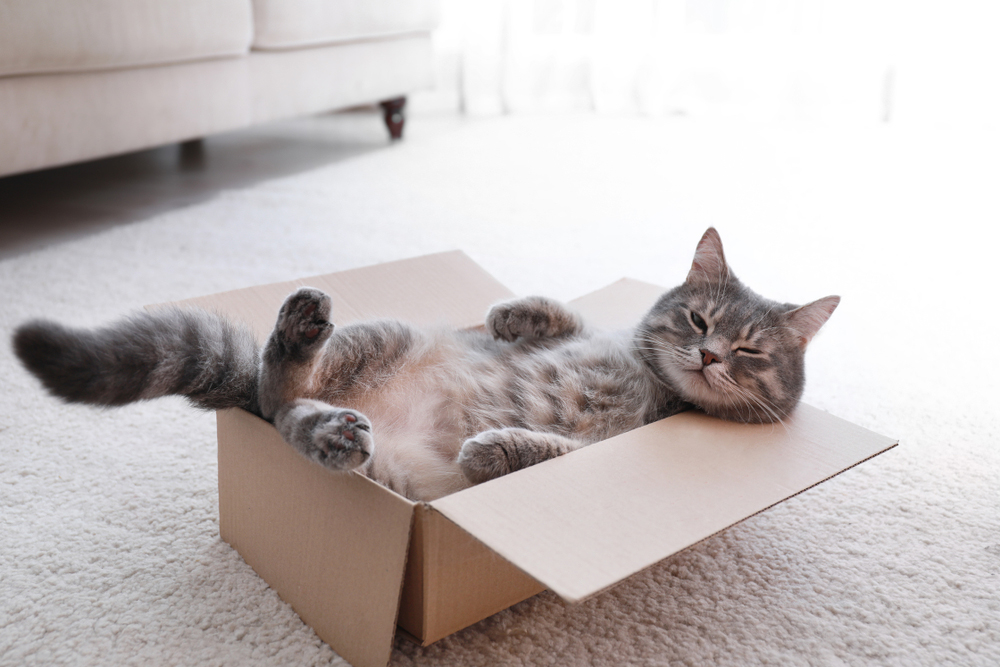
Generated Output:
3.2. Multimodal Understanding Task – Equation Description with OpenVINOTM
Prompt: Generate the latex code of this formula
Input Image:

Generated Output:
3.3. Multimodal Understanding Task – Code Generation with OpenVINOTM
Prompt: Generate the matplotlib pyplot code for this plot
Input Image:
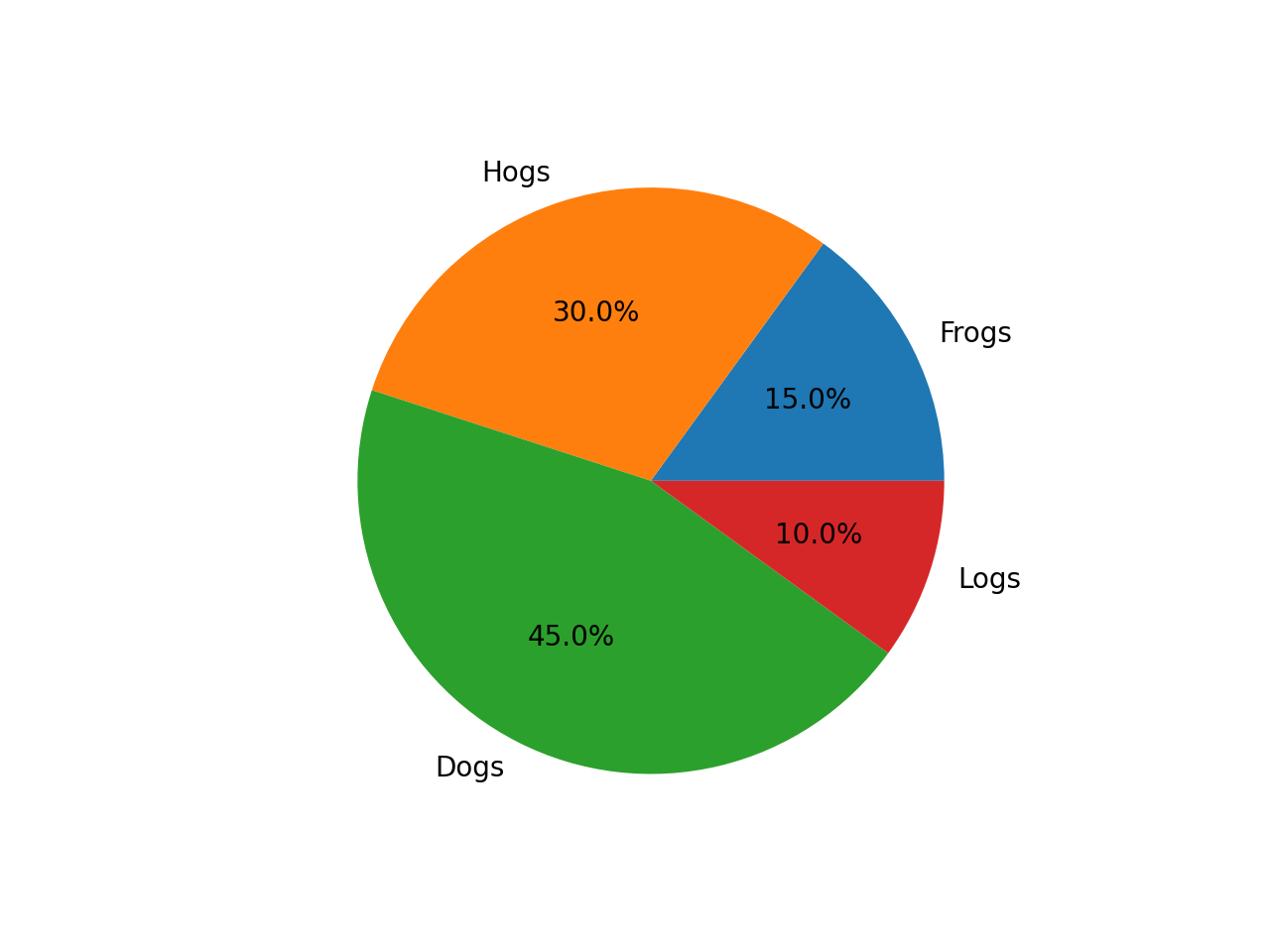
Generated Output:
3.4. Vision Generation Task with OpenVINOTM
Input Prompt: A cute and adorable baby fox with big brown eyes, autumn leaves in the background enchanting, immortal, fluffy, shiny mane, Petals, fairyism, unreal engine 5 and Octane Render, highly detailed, photorealistic, cinematic, natural colors.
Generated image:
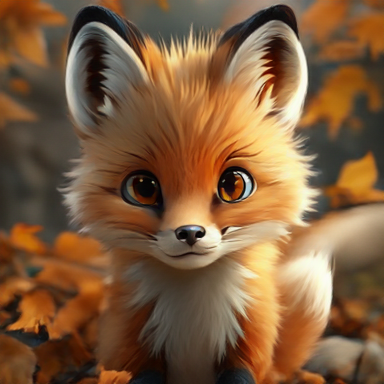

4. Performance Evaluation & Memory Usage Analysis
We also provide benchmark scripts to evaluate Janus-Pro model performance and memory usage with OpenVINOTM inference, you may specify model name and device for your target platform.
4.1. Benchmark Janus-Pro for Multimodal Understanding Task with OpenVINOTM
Here are some arguments for benchmark script for Multimodal Understanding Task:
--model_id: specify the Janus OpenVINOTM model directory
--prompt: specify input prompt for multimodal understanding task
--image_path: specify input image for multimodal understanding task
--niter: specify number of test iteration, default is 5
--device: specify which device to run inference
--max_new_tokens: specify max number of generated tokens
By default, the benchmark script will run 5 round multimodal understanding tasks on target device, then report pipeline initialization time, average first token latency (including preprocessing), 2nd+ token throughput and max RSS memory usage.
4.2. Benchmark Janus-Pro for Text-to-Image Task with OpenVINOTM
Here are some arguments for benchmark scripts for Text-to-Image Task
--model_id: specify the Janus OpenVINO TM model directory
--prompt: specify input prompt for text-to-image generation task
--niter: specify number of test iteration
--device: specify which device to run inference
By default, the benchmark script will run 5 round image generation tasks on target device, then report the pipeline initialization time, average image generation latency and max RSS memory usage.
5. Conclusion
In this blog, we introduced how to enable Janus-Pro model with OpenVINOTM runtime, then we demonstrated the Janus-Pro capability for various multimodal understanding and image generation tasks. In the end, we provide python script for performance & memory usage evaluation for both multimodal understanding and image generation task on target platform.
moondream2 model enabling with OpenVINO
Introduction
moondream2 is a small vision language model designed to run efficiently on edge devices. Although the model has a small number of parameters, it provides high-performance visual processing capabilities. It can quickly understand and process input images and respond to user queries. The model was developed by VikhyatK and is released under the permissive Apache 2.0 license, allowing for commercial use.
You can find more information on github repository: https://github.com/zhaohb/moondream2-ov
OpenVINOTM backend on moondream2
Step 1: Install system dependency and setup environment
Create and enable python virtual environment
conda create -n ov_py310 python=3.10 -y
conda activate ov_py310
Clone themoondream2-ov repository from gitHub
git clone https://github.com/zhaohb/moondream2-ov
cd moondream2-ov
Install python dependency
pip install -r requirement.txt
pip install --pre -U openvino openvino-tokenizers --extra-index-url https://storage.openvinotoolkit.org/simple/wheels/nightly
Step 2: Get HuggingFace model
git lfs install
git clone https://hf-mirror.com/vikhyatk/moondream2
git checkout 48be9138e0faaec8802519b1b828350e33525d46
Step 3: Export OpenVINO™ models and simple inference test with OpenVINO™
python3 test_ov_moondream2.py -m /path/to/moondream2 -o /path/to/moondream2_ov
Question: Describe this image.
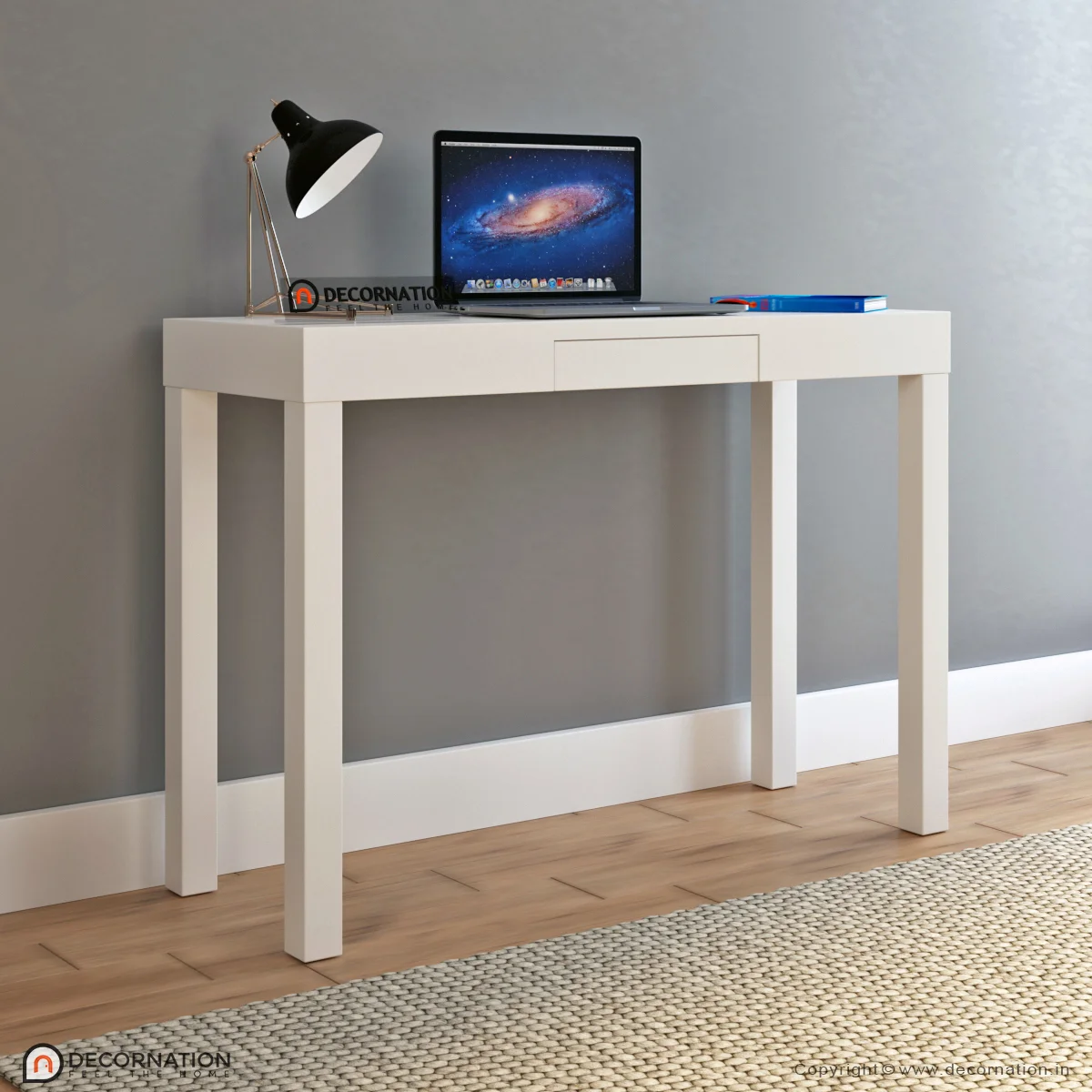
Answer:
The image shows a modern white desk with a laptop, a lamp, and a notebook on it, set against a gray wall and a wooden floor.
Large Language Model Graph Customization with OpenVINO™ Transformations API
Authors: Xiake Sun, Wenyi Zou, Fiona Zhao
Introduction
A Large Language Model (LLM) is a type of artificial intelligence algorithm that uses deep learning techniques and massively large data sets to understand, summarize, generate and predict new content.
OpenVINO™ optimizes the deployment of LLMs, enhancing their performance and integration into various applications. We already provide general guide to use LLMs with OpenVINO™, from model loading and conversion to advanced use cases.
In this blog, we will introduce some useful method to customize Large Language model’s graph with OpenVINO™ transformation API.
OpenVINO™ Runtime has three main transformation types:
- Modelpass: straightforward way to work with ov::Model directly
- Matcherpass: pattern-based transformation approach
- Graphrewrite pass: container for matcher passes needed for efficient execution.

In this blog, we mainly use ov::pass::MatcherPassto customize model subgraph via pattern-based transformation.
Here are common steps to implement graph customization using ov::pass::MatcherPass.
- Create a pattern
- Implement a callback
- Register the pattern and Matcher
- Execute MatcherPass
In this blog, we will use an open-source LLMs Qwen1.5-7B-Chat-GPTQ-Int4 from Alibaba Cloud with guide for model conversion and graph customization methods.
Qwen Pytorch to OpenVINO™ Model conversion
Here we can use openvino.genai repo to convert Qwen1.5 GPTQ INT4 Pytroch model to OpenVINO™model.
Converted model can be find in path “Qwen1.5-7B-Chat-GPTQ-Int4-OV/pytorch/dldt/GPTQ_INT4-FP16/".
Insert custom layer to OpenVINO™ model
Vocabularysize in the context of LLMs refers to the total number of unique words, or tokens, that the model can recognize and use. The larger the vocabulary size,the more nuanced and detailed the model’s understanding of language can be,however, it also requires more computational and memory resources for deployment. E.g. Qwen’s vocabulary size(151936) is almost 5x that Llama2 (32000), therefore additional optimization is required for efficient deployment.
We found that the following pattern existed in the Qwen model in Figure 2:

To compute the first token generation for the input prompt with shape [1, seq_length], we need to calculate a MatMul operation based on two inputs.
- First input is a reshape node output with shape[1, seq_length, 4096]
- Second input is a constant value that contains the model’s vocabulary with shape [4096,151936]
Then Matmul calculates two inputs [1, seq_length, 4096] * [4096,151936] to output large logits [1, seq_length,151936]. However, for the next token prediction, we only need the last element [1,4096] in 1st dimension from logits for sampling.
The main idea is to insert a slice operation between Reshape and Matmul nodes to extract only the last element in 2nd dimension of reshape node output as the first input with shape [1,4096] for computation. Therefore, Matmul computation can be reduced from [1, seq_len, 4096] * [1, 4096, 151936] = [1, seq_len, 151936] to [1, 1, 4096] *[4096, 151936] = [1, 1, 151936], which can reduce first token latency and memory consumption.
Here is a sample code to implement the workflow defined in Figure2 to reduce Qwen's last Matmul computation and memory usage:
We defined a OpenVINO™ transformation "InsertSlice" to find the logits (Results) node via ov::pass::MatchPass, then search along root->parent->grandparent node to find the Reshape node. Afterward, we insert a Slice node between the Reshape and Matmul nodes to extract the last element of seq_length with shape [1,1,4096]. In the end, we apply "InsertSlice" transformation to original OpenVINO™ model and save modified model on disk for deployment.
Modify model weights of specified layer in OpenVINO™ model
In case you want to update certain model layer weights after model training or fine-tuning/compression.
E.g. if you have an INT4 weight-compressed model using another model compression method, e.g. AWQ, you may want to transfer model weights optimized with the quantization method.
The most general method will be to convert the original model to OpenVINO™ model if the model direct conversion works. However, if first option is not works out of box, an alternative option is to replace the model weights from OpenVINO™ models with external fine-tuning model weights.

Here we introduce a common method to modify layer weights of Qwen model via OpenVINO™ transformation API.
As Figure 3 shows, the goal is to replace model weights and scale of the original Constant node with external fine-tuned weights and scale data.
At first, we use ov::pass::MatchPass method to find the Convert node after the target node. Then we create a new constant node with external weight saved as a numpy array. Please note, GPTQ int4 model weight is saved asuint4 (U4) binary format, while numpy can only represent data with numpy.uint8. Therefore, we use a help function to pack 2 uint4 binary data as 1 uint8 binary data. Then we replace the Convert input port from the original Constant node to the new Constant node. Since the old constant node has no consumers and is neither the Result nor the Sink operation whose shared pointer counter is zero, the operation will be destructed and not be accessible anymore.
Here is a sample code to implement the workflow defined in Figure3 to replace Qwen Constant node via the new Constant node with external data:
We defined a OpenVINO™ transformation "InsertWeights" to find the target constant node via ov::pass::MatchPass, then we create a new Constat node with external numpy data and pack it as uint4 OpenVINO™ Tensor to replace original constant node in graph. In the end, we apply "InsertWeights" transformation to original OpenVINO™ model and save modified model on disk for deployment.
Conclusion
In this blog, we introduce how to apply graph customization based on OpenVINO™ model with OpenVINO™ transformation API. Furthermore, we show two examples of inserting layers & modifying layer weights based on Qwen LLM model with simple Python code.
Reference
IntegrateOpenVINO™ with Your Application – Model Representation
AquilaChat-7B Language Model Enabling with Hugging Face Optimum Intel
Introduction
What is AquilaChat-7B Language Model?

Aquila Language Model is a set of open-source large language models (LLMs) developed by the Beijing Academy of Artificial Intelligence (BAAI). Aquila models support both Chinese and English, commercial license agreements, and compliance with Chinese domestic data regulations.
AquilaChat-7B is a conversational language model that supports Chinese and English dialogue. It is based on the Aquila-7B foundation model and fine-tuned using supervised fine-tuning (SFT). AquilaChat-7B original Pytorch model and configurations are publicly available here.
Hugging Face Optimum Intel

Hugging Face is one of the most popular open-source data science and machine learning platforms. It acts as a hub for AI experts and enthusiasts—like a GitHub for AI. Over 200,000 models are available across Natural language processing, Multimodal models, Computer Vision, and Audio domains.
Hugging Face provides wide support for model optimization and deployment of open-sourced LLMs such as LLaMA, Bloom, GPT-Neox, Dolly 2.0, to name a few. More details please refer to Open LLM Leaderboard.
Optimum-Intel provides a simple interface between the Hugging Face and OpenVINOTM ecosystem to leverage high-performance inference capabilities for Intel architecture. Here is a simple example to show how to run Dolly 2.0 models with OVModelForCausalLM using OpenVINOTM runtime.
Hola! So, for LLMs already supported by Hugging Face transformers and optimum, we can smoothly switch the model inference backend from Pytorch to OpenVINOTM by changing only two lines of code.
However, what if an LLM from an open-source community that not native supported by Hugging Face Transformers library? How can we still leverage the tools of Hugging Face and OpenVINOTM ecosystem for model optimization and deployment?
Indeed, AquilaChat-7B is a custom model for the Hugging Face Transformers. So, we use it as an example to elaborate the custom model enabling methodology step by step.
How to Enable a Custom Model on Hugging Face?
To leverage the Hugging Face ecosystem and optimization for AquilaChat-7B model, we need to convert the original Pytorch model to Hugging Face Format. Before we dive into conversion details, we need to figure out what is AquilaChat-7B’s model structure, tokenizer, and configurations.
According to Aquila’s official model description:
“The Aquila language model inherits the architectural design advantages of GPT-3 and LLaMA, replacing a batch of more efficient underlying operator implementations and redesigning the tokenizer for Chinese-English bilingual support. The Aquila language model is trained from scratch on high-quality Chinese and English corpora. “
Model Structure and Tokenizer
For model structure, Aquila Model adopts the original Meta LLaMA pytorch implementation, which combines RMSNorm (GPT-3) to improve training stability and Rotary Position Embedding (GPT-NeoX)to incorporate explicit relative position dependency in self-attention.
For tokenizer, instead of using byte-pair encoding (BPE) algorithms implemented by Sentence Piece, Aquila re-trained HuggingFace GPT-NeoX tokenizer with extended vocabulary (vocab_size =100008, including 8 special tokens, e.g. bos_token=100006, eos_token=100007, unk=0, pad=0 used for inference based on here.
Rotary Position Embedding
Rotary Position Embedding (RoPE) encodes the absolute position with a rotation matrix and meanwhile incorporates the explicit relative position dependency in the self-attention formulation. Compare to other position embedding methods, RoPE provides valuable properties such as flexibility of sequence length, long-term decay, and linear self-attention with relative position embedding. Based on the original paper, there are two mainstream implementations of RoPE:
As show in Figure 3, Meta LLaMA’s implementation directly use complex number to calculate rotary position embedding.
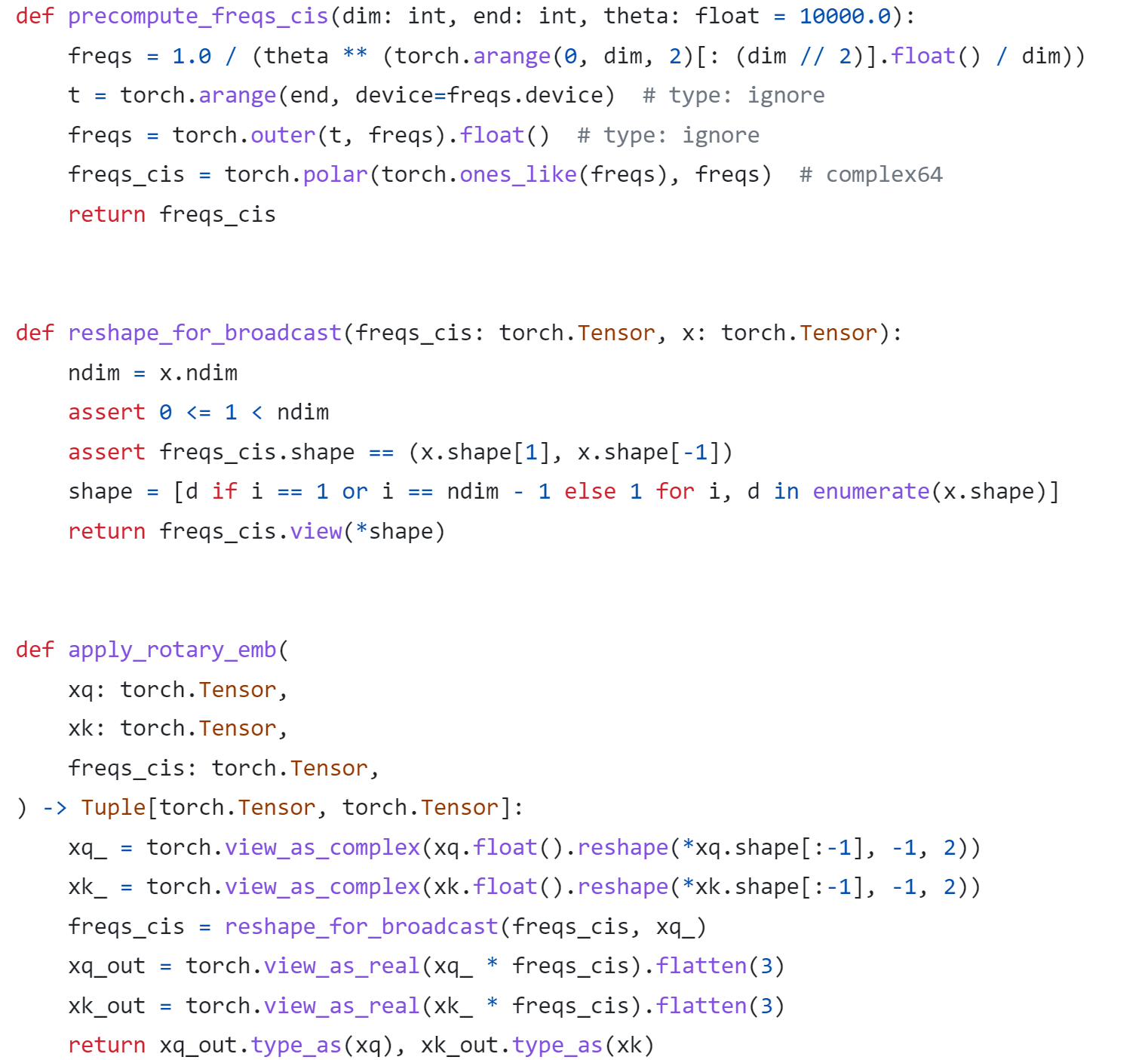
As show in Figure 4, Google PaLM’s implementation expands the complex number operation and calculate sinusoidal functions in matrix equation of real numbers.

Both RoPE implementations are valid for the Pytorch model. Hugging Face LLaMA implementation adopts PaLM’s RoPE implementation due to the limitation of complex type support for ONNX export.
Besides, Hugging Face provides a useful script convert_llama_weights_to_hf.py to convert the original Meta LLaMA Pytorch Model to Hugging Face Format as follows:
- Extract Pytorch weights and convert Meta LlaMA RoPE implementation to Hugging Face RoPE implementation.
- Convert tokenizer.model trained with Sentence Piece to Hugging Face LLaMA tokenizer.
Convert AquilaChat-7B Model to Hugging Face Format
Similarly, we provide a convert_aquila_weights_to_hf.py to convert AquilaChat-7B Model to Hugging Face Format.
- Extract Pytorch weights and convert Aquila RoPE implementation to Hugging Face RoPE implementation
- Initialize and save a Hugging Face GPT-NeoX Tokenizer with extended vocabulary based on original tokenizer configurations provided by Aquila.
- Add a modeling_aquila.py to enable support forAutoModelForCausalLM and AutoTokenizer
Here is the converted Hugging Face version of AquilaChat-7B v0.6 model uploaded in Hugging Face.
You may convert pytorch weights to Hugging Face format in two steps:
- Download AquilaChat-7B Pytorch Model and configurations here
- Convert AquilaChat-7B Pytorch Model and configurations to Hugging Face Format
Hugging Face AquilaChat-7B Demo
Setup Environment
Run inference with AutoModelForCausalLM
Run inference with OVModelForCausalLM
Conclusion
In this blog, we show how to convert a custom Large Language Model (LLM) to Hugging Face format to leverage efficient optimization and deployment with Hugging Face and OpenVINOTM Ecosystem.
Please note, this is the initial model enabling step for AquilaChat-7B model with OpenVINOTM. We will continue to optimize performance along with upgrading OpenVINOTM for LLM scaling. Please refer to OpenVINOTM and Optimum-Intel official release to get latest efficient support for LLMs with OpenVINOTM backend.
Reference
- FlagAI AquilaChat-7B
- AquilaChat-7B Hugging Face Model
- Hugging Face Optimum Intel
- LLaMA:Open and Efficient Foundation Language Models
- RoFormer:Enhanced Transformer with Rotary Position Embedding
- RotaryEmbeddings: A Relative Revolution
Enable chatGLM by creating OpenVINO™ stateful model and runtime pipeline
Authors: Zhen Zhao(Fiona), Cheng Luo, Tingqian Li, Wenyi Zou
Introduction
Since the Large Language Models (LLMs) become the hot topic, a lot Chinese language models have been developed and actively deployed in optimization platforms. chatGLM is one of the popular Chinese LLMs which are widely been evaluated. However, ChatGLM model is not yet a native model in Transformers, which means there remains support gap in official optimum. In this blog, we provide a quick workaround to re-construct the model structure by OpenVINO™ opset contains custom optimized nodes for chatGLM specifically and these nodes has been highly optimized by AMX intrinsic and MHA fusion.
*Please note, this blog only introduces a workaround of optimization method by creating OpenVINO™ stateful model for chatGLM. This workaround has limitation of platform, which requires to use Intel® 4th Xeon Sapphire Rapids with AMX optimization. We do not promise the maintenance of this workaround.
Source link: https://github.com/luo-cheng2021/openvino/tree/luocheng/chatglm_custom/tools/gpt
To support more LLMs, including llama, chatglm2, gpt-neox/dolly, gpt-j and falcon. You can refer this link which not limited on SPR platform, also can compute from Core to Xeon:
Source link: https://github.com/luo-cheng2021/ov.cpu.llm.experimental
ChatGLM model brief
If we check with original model source of chatGLM, we can find that the ChatGLM is not compatible with Optimum ModelForCasualML, it defines the new class ChatGLMForConditionalGeneration. This model has 3 main modules (embedding, GLMBlock layers and lm_logits) during the pipeline loop, the structure is like below:
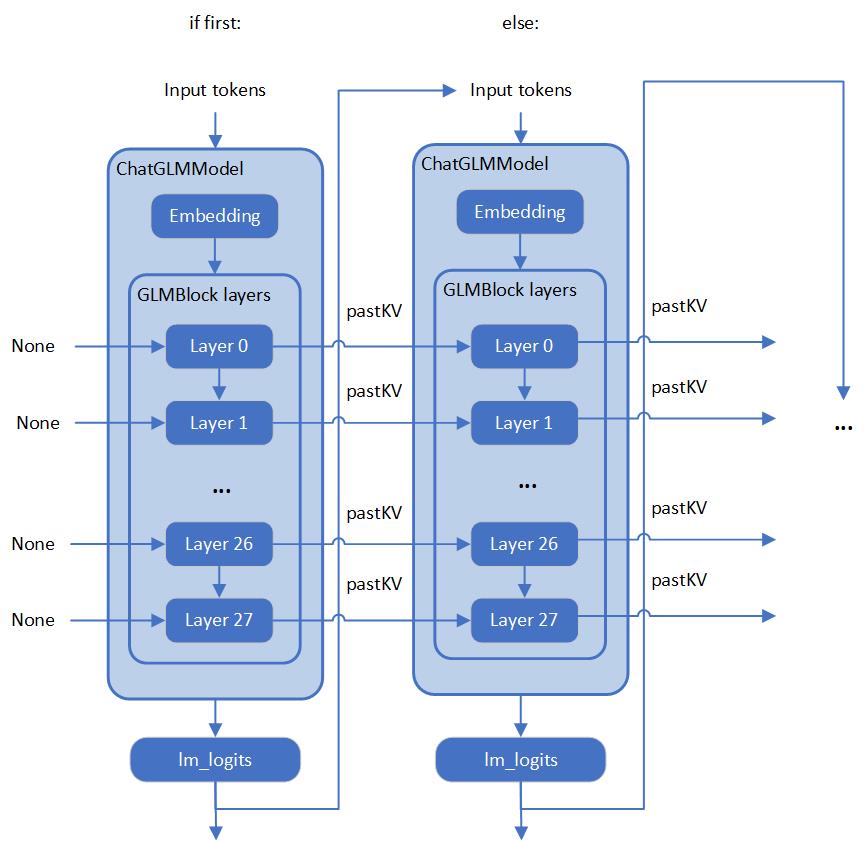
As you can see, the whole pipeline actually require model with two different graphs, the first-time inference with input prompt tokens do not require KV cache as inputs for GLMBlock layers. Since the second iteration, the previous results of QKV Attention should become the inputs of current round model inference. Along with the length of generated token increased, there will remain a lot of large sized memory copies between model inputs and outputs during pipeline inference. We can use ChatGLM6b default model configurations as an example, the memory copies between input and output arrays are like below pseudocode:
Therefore, two topics is the most important:
- How we can optimize model inference pipeline to eliminate memory copy between model inputs and outputs
- How we can put optimization efforts on GLMBlock module by reinvent execution graph
Extremely optimization by OpenVINO™ stateful model
Firstly, we need to analyze the structure of GLMBlock layer, and try to encapsulate a class to invoke OpenVINO™ opset with below workflow. Then serialize the graph to IR model(.xml, .bin).

To build an OpenVINO™ stateful model, you can refer to this document to learn.
https://docs.openvino.ai/2022.3/openvino_docs_OV_UG_network_state_intro.html
OpenVINO™ also provide model creation sample to show how to build a model by opset.
https://github.com/openvinotoolkit/openvino/blob/master/samples/cpp/model_creation_sample/main.cpp
It is clear to show that the emphasized optimization block is the custom op of Attention for chatGLM. The main idea is to build up a global context to store and update pastKV results internally, and then use intrinsic optimization for Rotary Embedding and Multi-Head Attentions. In this blog, we provide an optimized the attention structure of chatGLM with AMX intrinsic operators.
At the same time, we use int8 to compress the weights of the Fully Connected layer, you are not required to compress the model by Post Training Quantization (PTQ) or process with framework for Quantization Aware Training(QAT).
Create OpenVINO™ stateful model for chatGLM
Please prepare your hardware and software environment like below and follow the steps to optimize the chatGLM:
Hardware requirements
Intel® 4th Xeon platform(codename Sapphire Rapids) and above
Software Validation Environment
Ubuntu 22.04.1 LTS
python 3.10.11 for OpenVINO™ Runtime Python API
GCC 11.3.0 to build OpenVINO™ Runtime
cmake 3.26.4
Building OpenVINO™ Source
- Install system dependency and setup environment
- Create and enable python virtual environment
- Install python dependency
- Build OpenVINO™ with GCC 11.3.0
- Clone OpenVINO™ and update submodule
- Install python dependency for building python wheels
- Create build directory
- Build OpenVINO™ with CMake
- Install built python wheel for OpenVINO™ runtime and openvino-dev tools
- Check system gcc version and conda runtime gcc version. If the system gcc version is higher than conda gcc version like below, you should update conda gcc version for OpenVINO runtime. (Optional)
- convert pytorch model to OpenVINO™ IR
Use OpenVINO Runtime API to build Inference pipeline for chatGLM
We provide a demo by using transformers and OpenVINO™ runtime API to build the inference pipeline. In test_chatglm.py, we create a new class which inherit from transformers.PreTrainedModel. And we update the forward function by build up model inference pipeline with OpenVINO™ runtime Python API. Other member functions are migrated from ChatGLMForConditionalGeneration from modeling_chatglm.py, so that, we can make sure the input preparation work, set_random_seed, tokenizer/detokenizer and left pipelined operation can be totally same as original model source.
To enable the int8 weights compress, you just need a simple environment variable USE_INT8_WEIGHT=1. That is because during the model generation, we use int8 to compress the weights of the Fully Connected layer, and then it can use int8 weights to inference on runtime, you are not required to compress the model by framework or quantization tools.
Please follow below steps to test the chatGLM with OpenVINO™ runtime pipeline:
- Run bf16 model
- Run int8 model
Weights compression reduces memory bandwidth utilization to improve inference speed
We use VTune for performance comparison analysis of model weights bf16 and int8. Comparative analysis of memory bandwidth and CPI rate (Table 1). When model weight is compressed to int8, it can reduce memory bandwidth utilization and CPI rate.



Clockticks per Instructions Retired(CPI) event ratio, also known as Cycles per Instructions, is one of the basic performance metrics for the hardware event-based sampling collection, also known as Performance Monitoring Counter (PMC) analysis in the sampling mode. This ratio is calculated by dividing the number of unhalted processor cycles(Clockticks) by the number of instructions retired. On each processor the exact events used to count clockticks and instructions retired may be different, but VTune Profiler knows the correct ones to use.
A CPI < 1 is typical for instruction bound code, while a CPI > 1 may show up for a stall cycle bound application, also likely memory bound.
Conclusion
Along with the upgrading of OpenVINO™ main branch, the optimization work in this workaround will be generalized and integrated into official release. It will be helpful to scale more LLMs model usage. Please refer OpenVINO™ official release and Optimum-intel OpenVINO™ backend to get official and efficient support for LLMs.
MiniCPM-V-2 model enabling with OpenVINO
Introduction
MiniCPM is an End-Side LLM developed by ModelBest Inc. and TsinghuaNLP. MiniCPM-V is a series of end-side multimodal LLMs (MLLMs) designed for vision-language understanding. The models take image and text as inputs and provide high-quality text outputs. MiniCPM-V 2.0 is an efficient version with promising performance for deployment. The model is built based on SigLip-400Mand MiniCPM-2.4B, connected by a perceiver resampler. On this blog, we provide the OpenVINO™ optimization for MiniCPM-V 2.0 on Intel® platforms.
You can find more information on GitHub repository:https://github.com/OpenBMB/MiniCPM-V
OpenVINO™backend on Minicpm-V-2
Step 1: Install system dependency and setup environment
Create and enable python virtual environment
Clone the MiniCPM-V repository from GitHub
Chage the current directory to the MiniCPM-V OpenVINO™ Runtime folder
Install python dependency
Step2: Export to OpenVINO™ models
Step3: Simple inference test with OpenVINO™
Question: Describe the content of the image
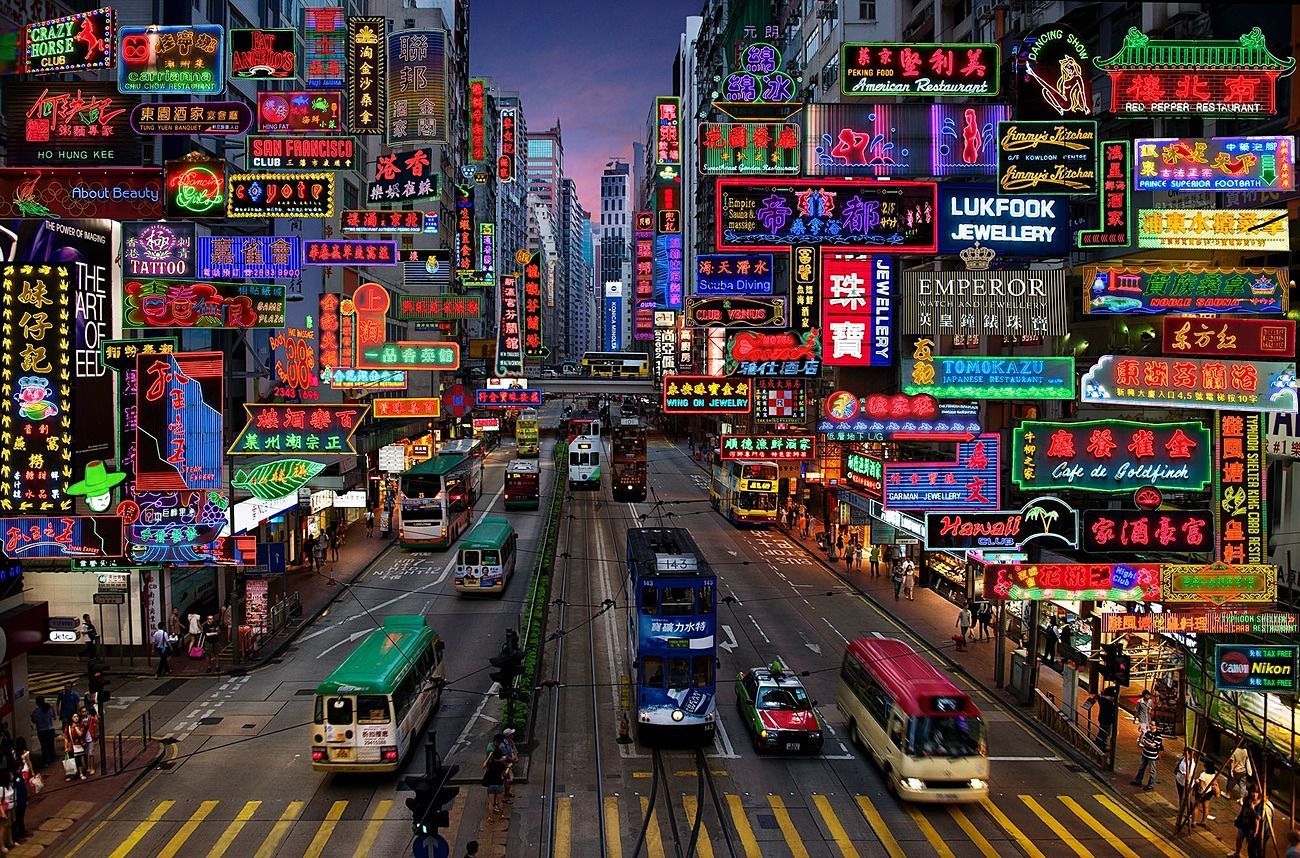
Answer:
The image captures the vibrant and bustling atmosphere of abusy city street in Hong Kong. The street is lined with an array of neon signsand billboards, each one advertising a different business or establishment. Thesigns are in a variety of languages, including English, Chinese, and Japanese,reflecting the multicultural nature of the city.
The street itself is a hive of activity with several busesand a tram making their way through the traffic. The vehicles are in motion,adding a dynamic element to the scene.
The sky above is a beautiful gradient of colors,transitioning from a deep blue at the top to a lighter shade at the bottom.This suggests that the photo was taken during either sunrise or sunset, castinga warm glow over the cityscape.
The image also contains several text elements, including thenames of various establishments and the brand names of products. These textsadd another layer of information to the scene, providing insights into thenature of the businesses and the products they offer.
Overall, the image provides a vivid snapshot of life in HongKong, capturing the city's vibrant energy and the diverse range of businessesand products that make up its bustling streets.

